Music is the universal language
“Glory to God in the highest heaven, and on earth peace to those on whom his favor rests.” - Luke 2:14
Premier Guitar
Stompin’ to the Top: Meet Three of the Most Successful Independent Pedal Companies

We’ve been basking in the golden age of guitar-effects pedals for some time now, but somehow things just seem to keep getting better and better. Holy-grail tones have been decoded and transcribed into pedal form, even as radical new stompbox inventions give musicians the ability to create new ones. And guitarists’ pedalboards are no longer governed by the biggest names in pedal manufacturing. These days, you’re just as likely to see a Boss DS-1 on someone’s board as you are a one-off build from a friend of a friend.
The ground between the majors and the building-for-fun crowd is filled with passionate pedal makers who are changing how guitarists approach their instruments. In this piece, we’ll introduce you to three North American pedal companies who have changed the pedal game with unique sounds, community-minded approaches, and years of hard work—plus, a quick word on their top stomps.
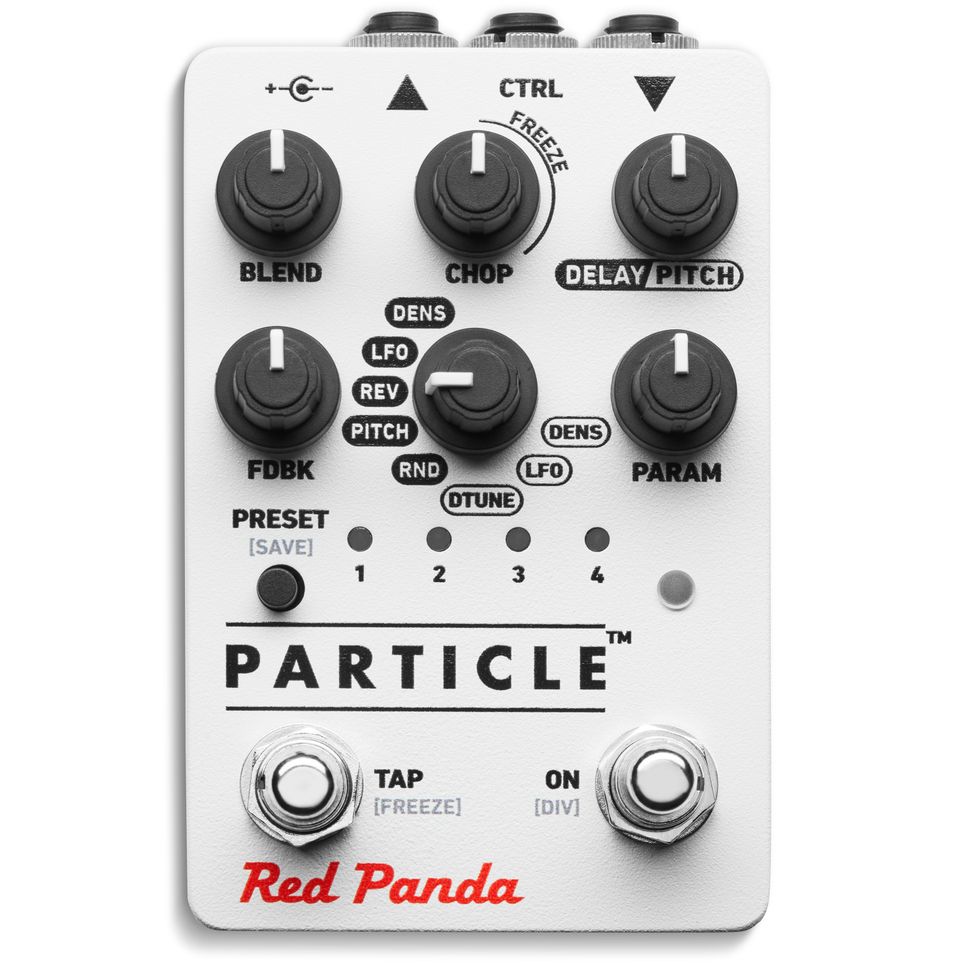
Red Panda
Biggest Hit: Particle
The Story:
Curt Malouin isn’t a guitar player, and he didn’t set out to make guitar-effects pedals, yet that’s exactly what happened with Red Panda. Malouin was working a demanding software engineering job and had been building modular software for 15 years before he started soldering pedals in his garage in 2009, but his love for electronics began when he was 11. Malouin says that having Asperger’s syndrome facilitated his obsession with sound: “I was really super interested and focused on using algorithms to manipulate sound and zoom in on little details of the sound,” he says. “It’s what my brain is focused on most of the time.”

Malouin messed around with drum machines, synths, and turntables when he was growing up in metro Detroit, listening to techno and hip-hop created in the city. Pedals were of a piece with those scenes: tools in a sound creator’s kit that were highly tweakable and allowed for brilliant manipulation, like how DJs and hip-hop artists used both old and new technologies to create unique sounds. When Line 6’s ToneCore pedals, like the Echo Park delay and Verbzilla, dropped, Malouin discovered that they included interchangeable modules that allowed users to modify the DSP code. It happened to be the same code he used in college while studying electrical engineering. That helped bridge his expertise with his new interests. “It was a combination of wanting to get back to something a little more simple and physical than working on software,” he says.
In 2011, Red Panda released the Particle, Malouin’s first ground-up design and the first-ever granular delay pedal. Word spread about this one-man operation building deeply featured digital pedals. Four years later, Malouin moved to a shared workshop. Another five years passed before Red Panda moved into its current office and workshop.
Red Panda’s builds are entirely digital, and feature-wise, they’re more complex than your average stomp. As a rule, they’re equipped with stereo inputs and outputs, full MIDI implementation, and web-based editing. Malouin is the engineer behind every step of their creation—he even built the operating system that runs the algorithms and digital signal processing (DSP) code. Malouin says that involvement keeps Red Panda’s conceptual integrity consistent from top to bottom.
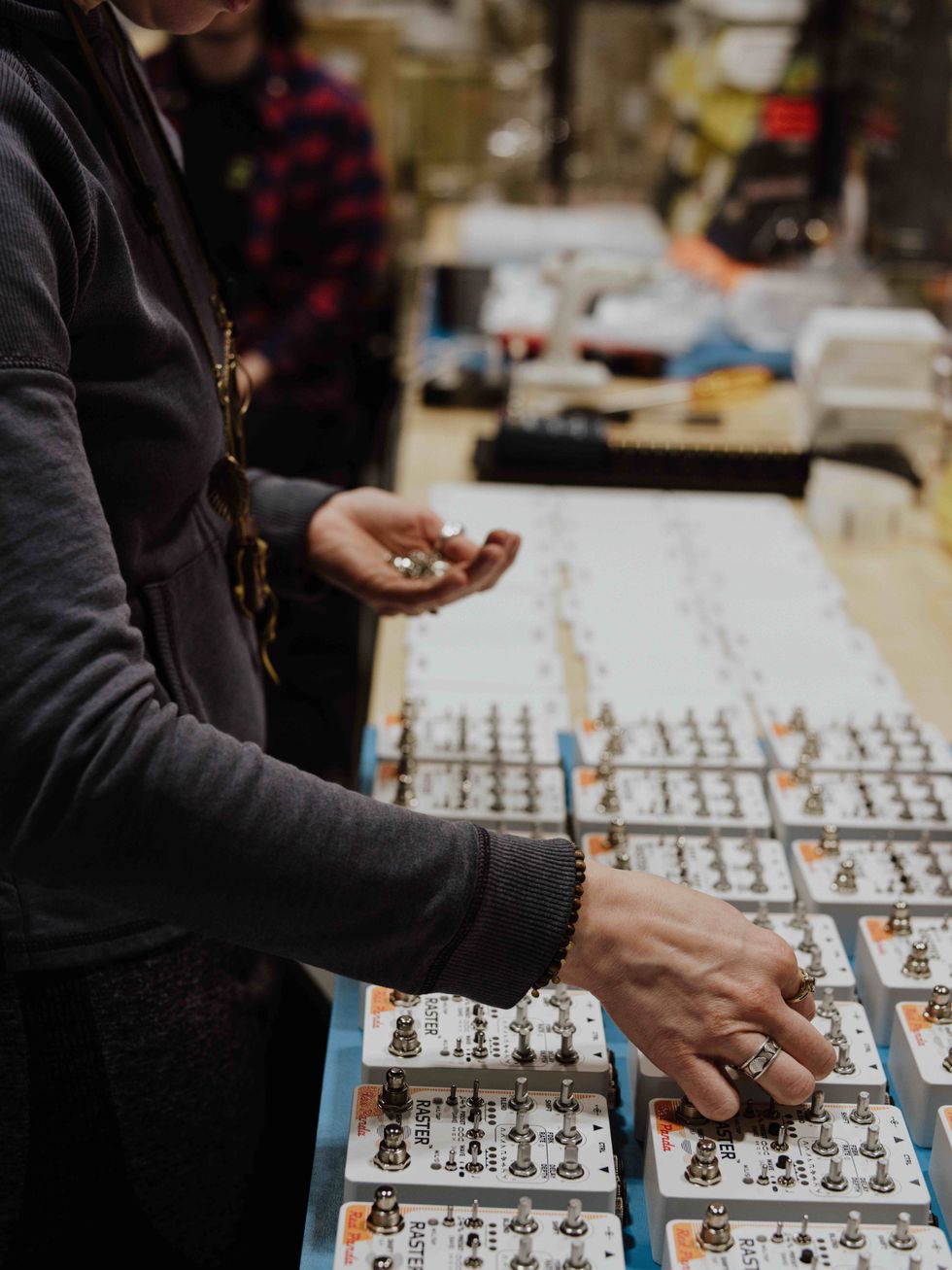
Red Panda’s new RD1 series, which has been in development for three years, aims to deliver these designs in a pared-back, more affordable package. They’ll feature the same algorithms as the flagship products, but with fewer features and more focused applications—something like an old-school pedal that “does one thing, and does it really well,” explains Malouin. “There’s a lot of fun engineering challenges in trying to keep something that sounds just as good as our other pedals, but we can sell at a lower price point that allows musicians to grab it and make interesting music.”
The pedals were ready to go in April this year, but Donald Trump’s volatile tariff applications made it impossible to meet the price target Malouin wanted to hit. Red Panda’s pedals are all assembled in Michigan, but he sources parts from around the world, many of which Malouin says will never be made in the U.S. He adapted by, once again, leaning on new processes to reduce costs; for example, designing the pedals to be as quick to assemble as possible, or replacing several components with one that can do multiple things. “It’s a little engineering magic trick that makes this work fun,” he says.
Red Panda has grown since its beginning, but not by much. Malouin and only three others are day-to-day, full-time workers, which means everyone handles a bit of everything, from assembly to orders to shipping to video productions.
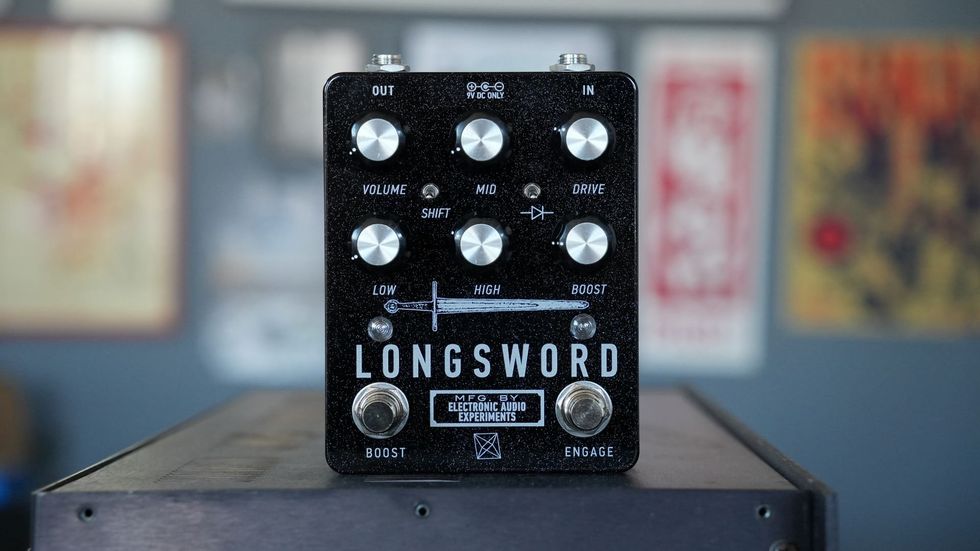
Electronic Audio Experiments
(electronicaudioexperiments.com)
Biggest Hit: Longsword
The Story:
It’s been just over 10 years since Boston-based pedal builder John Snyder released the first version of the Electronic Audio Experiments Longsword, but it wasn’t until 2020, when he began building full time, that the pedal reached its final form.
If you’re curious, though, you can see exactly how the Longsword evolved over the years. Snyder tracks and publishes all the changes to each of his pedal’s circuits over the years on EAE’s website. “For me, it was partly to quell confusion on the internet where people were like, ‘This version of this pedal has this thing and this version has this thing,’ or people saying, ‘I have this serial number, when did you change the board?’ I can just say, ‘Here’s the change log, it’s on the website, it’s in the manual.’ I wish other companies would do something similar.”

Snyder began playing in bands in middle school, and during his college years in the early 2010s he was active in the Northeast’s DIY community of emo, punk, and hardcore bands of all stripes. Influenced by a family heritage of engineers (one of his grandfathers was head of quality control at a vacuum-tube plant in Kentucky), Snyder was always the token gearhead in his circle. His bands were never too popular, which meant he had more time to focus on crafting unique sounds between short tours and weekend runs.
Dirt lovers around the world have a rare meteorological phenomenon to thank for their EAE pedals. In early 2014, Boston received more than 20 inches of snow over two days. Snyder was snowed into his illegal basement apartment, unable to visit his girlfriend (now wife) or any friends. It was during these locked-in days that Snyder breadboarded the Longsword. He built one for himself, and the following summer he sold a batch of 15.
Snyder finished a post-grad degree in electrical engineering in May 2020, and outside of the defense industry, there weren’t many prospects. After his wife suggested that he focus on building pedals, Snyder spent three months working on streamlining his processes. That turned into six months, which turned into a year. The operation didn’t fit into Snyder’s guest room anymore, so he upgraded to a real shop space for a while before landing on EAE’s current location, a corner of the second floor of a warehouse in Waltham, Massachusetts. (Their downstairs neighbours are Small Bear Electronics.)
“We’re all helping each other, which is a really awesome way to build community and make what we do more interesting. Something that I try to keep in mind is that this industry is so, so small, and we’re not really competing with each other.”–John Snyder, Electronic Audio Experiments
The Longsword was born from Snyder chasing the solid-state and op-amp distortion sounds of classic post-hardcore acts like Touché Amoré, La Dispute, and mewithoutYou. The Longsword’s lineage includes elements of the Boss HM-2, MXR Distortion+, and the Caroline Wave Cannon (which itself has some RAT DNA), but Snyder added a Baxandall EQ circuit. “I wanted something that didn’t already exist in the market and was very purpose-driven in its design, and could be unique enough to stand out,” explains Snyder.
Snyder credits mentors like Nick Williams of Dunwich Amplification with sharing their time and expertise in EAE’s early days: “[Nick] taught me a lot of the basics of, like, ‘How do I lay out circuit boards? How do I order circuit boards? Where do I find parts and stuff?’” Others shared meat-and-potatoes tips like how to drill enclosures in a bedroom without getting aluminum shavings everywhere, and how to market and build artist relations. Snyder tries to pay it forward these days by helping out new builders. “We’re all helping each other, which is a really awesome way to build community and make what we do more interesting,” says Snyder. “Something that I try to keep in mind is that this industry is so, so small, and we’re not really competing with each other. We’re all competing with Amazon Basics and Behringer.”
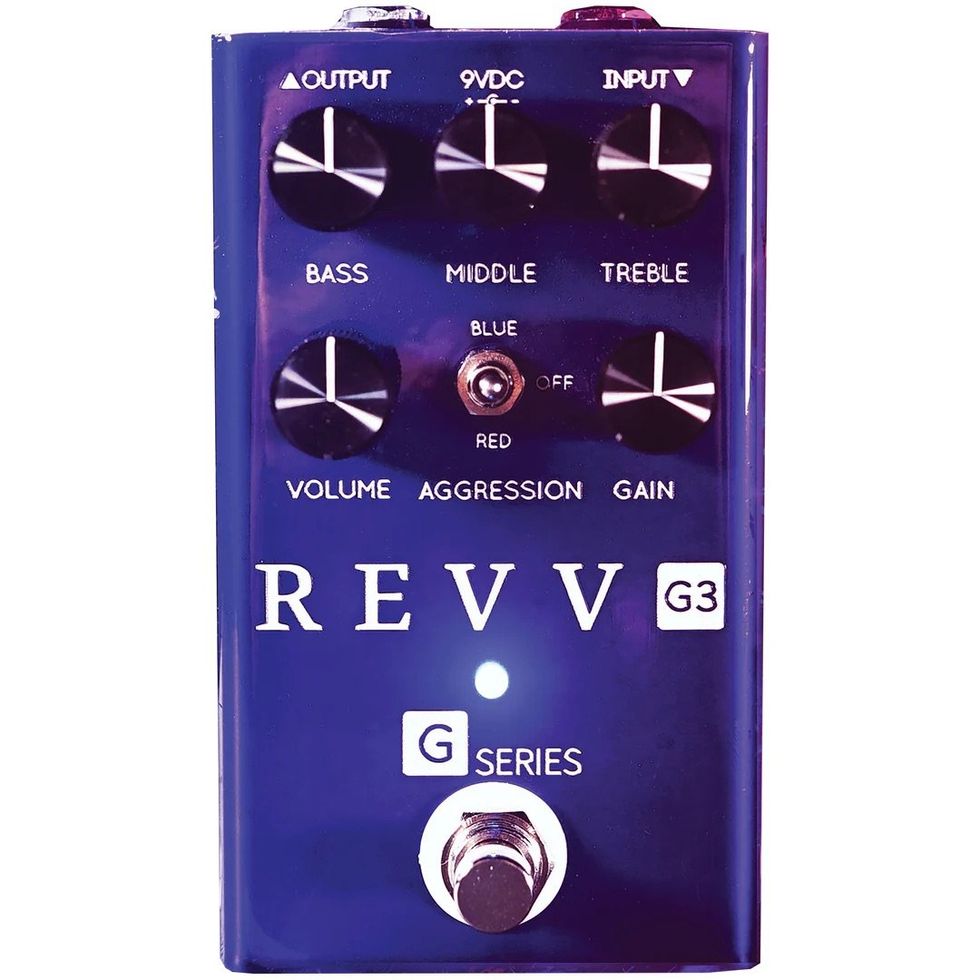
Revv
Biggest Hit: G3
(revvamplification.com)
The Story:
Winnipeg’s Revv Amplification made their name on the reputation of their excellent high-gain amplifiers, like the Generator 120. The 4-channel, flagship amp head was the sound in lead designer and president Dan Trudeau’s head. Trudeau, along with vice president of sales and marketing Derek Eastveld, took the formula a step further in 2018 when they put Revv’s rich, articulate, ground-shaking dirt into stompbox format.
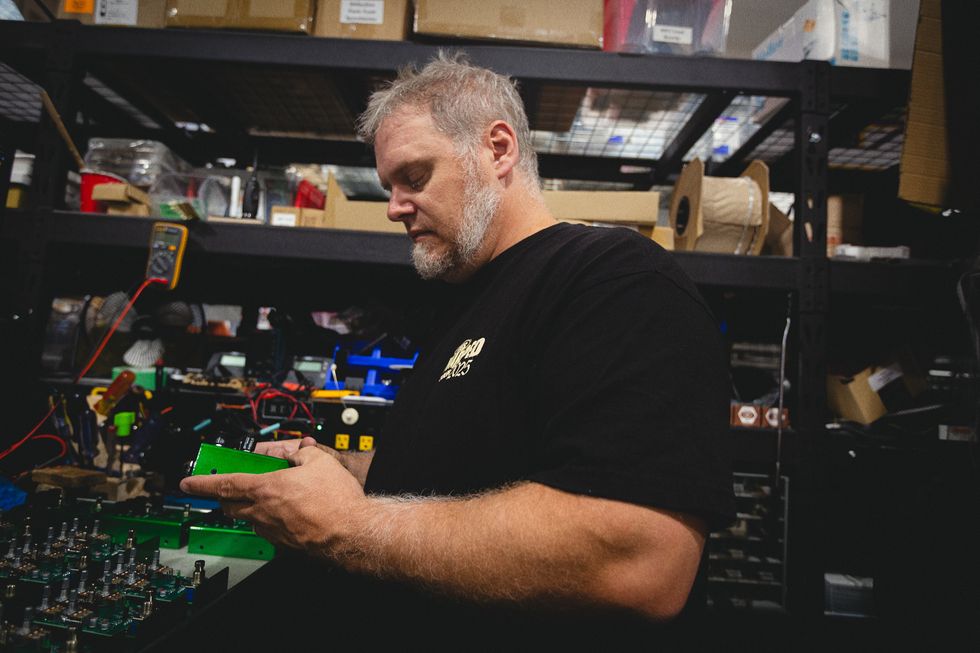
The day Revv’s G3 pedal launched in May 2018, Eastveld was on a flight to Germany. He and his colleagues had figured they would sell 250 of them in a year. By the time he landed later that day, they’d racked up 270 sales through their website. By the end of the month, they had more than 1,000 orders to fulfil. The success was exciting, but it also posed a problem: Revv only consisted of four full-time workers. The fateful launch provided the cash flow needed to scale up the company, and today 20 people work full-time for Revv, across production, marketing, sales, design, and administration.
Revv’s amp-in-a-box G-series pedals—G2, G3, and G4—are color-coded according to the corresponding channel on the Generator 120. The G2, for example, is green, because when the namesake amp’s second channel is engaged, the amp’s LED glows green. Eastveld says that means some people mistake the pedal for a Tube Screamer clone, which is a big mistake. The G2 is much more saturated and modern-sounding. Eastveld describes it as splitting the difference between contemporary high-gain monsters like Mesa Boogie Rectifiers and 5150s, and mid-gain classics like vintage Marshalls. The purple G3, though, remains Revv’s top-selling pedal. It’s even more modern, mid-focused, and aggressive, with a 3-position switch to navigate between different voicings and saturation levels.
“We’re always taking notes about like, ‘Okay, what did people respond well to, and what do we need to take another look at?’”–Derek Eastveld, Revv
Eastveld and Trudeau pride themselves on staying flexible and responsive to their users. They constantly monitor their social media for comments and suggestions. “Maybe somebody bought something and then sold it because it wasn’t a right fit for them, and we’re always taking notes about, like, ‘Okay, what did people respond well to, and what do we need to take another look at?’” explains Eastveld. That openness has led directly to amp and pedal upgrades. The G series pedals, including the famed G3, got a V2 makeover this year.
MayFly Audio releases the Terrain Deluxe Harmonic Optical Tremolo

The Terrain Deluxe is a Harmonic Tremolo with Tap Tempo, featuring a high fidelity all analog signal path using LightDependent Resistors (LDRs) for modulation. The Harmonic Tremolo mode uses an electronic crossover to split the signal into high and low frequency components.These are modulated 180 degrees out of phase and then re-combined creating a wet, lush tone. Speaking of tone, theTone control pans between the high and low frequency signals, going from full treble to full bass and everything in between. In the unlikely event that you get tired of the beautiful Harmonic Tremolo there is a Normal / Harmonic mode switch. In Normal Mode the high and low components are modulated together creating a traditional tremolo sound.
There are Speed, Depth, and Gain controls, and a Waveform switch to select between square, sine, and triangle waveforms.The Tap Tempo foot switch works win conjunction with the Tempo Multiplier switch allowing you to create quarter note, eight note, and eight note triplet modulations by just tapping the base tempo. The two tempo LEDs above the footswitch flash together in for Normal mode and 180 degrees out of phase in Harmonic mode.Finally, there are two independent expression pedal inputs: one each for Speed and Depth.
• Harmonic Tremolo with Tap Tempo.
• High fidelity all-analog signal path using LDRs.• Speed, Depth, and Gain controls.
• Tone control that sweeps between high and low frequency signals (center is flat).
• Normal / Harmonic mode switch.
• Sine, Square, and Triangle waveform switch.
• Tap Tempo footswitch with Tempo Multiplier switch.
• Independent expression pedal inputs for Speed and Depth controls.
• Full bypass with Fail Safe® using relays.
• 9VDC, 80mA.
MAP price: $220 USD ($299 CAD).
StewMac Launches Guitar Pedal Line With Four Hot Models
Building on the foundation of the company’s acclaimed pedalkits, StewMac has introduced a line of ready-to-play, fully finished guitar effects pedals.
The newly launched models include StewMac’s four most popular pedal designs: the Sun Fuzz; Lightcycle Phasor II optical phaser; Two Kings Boost dual overdrive; and Ghost Drive transparent overdrive. Each pedal delivers classic tone at an incredible price.
Sun Fuzz
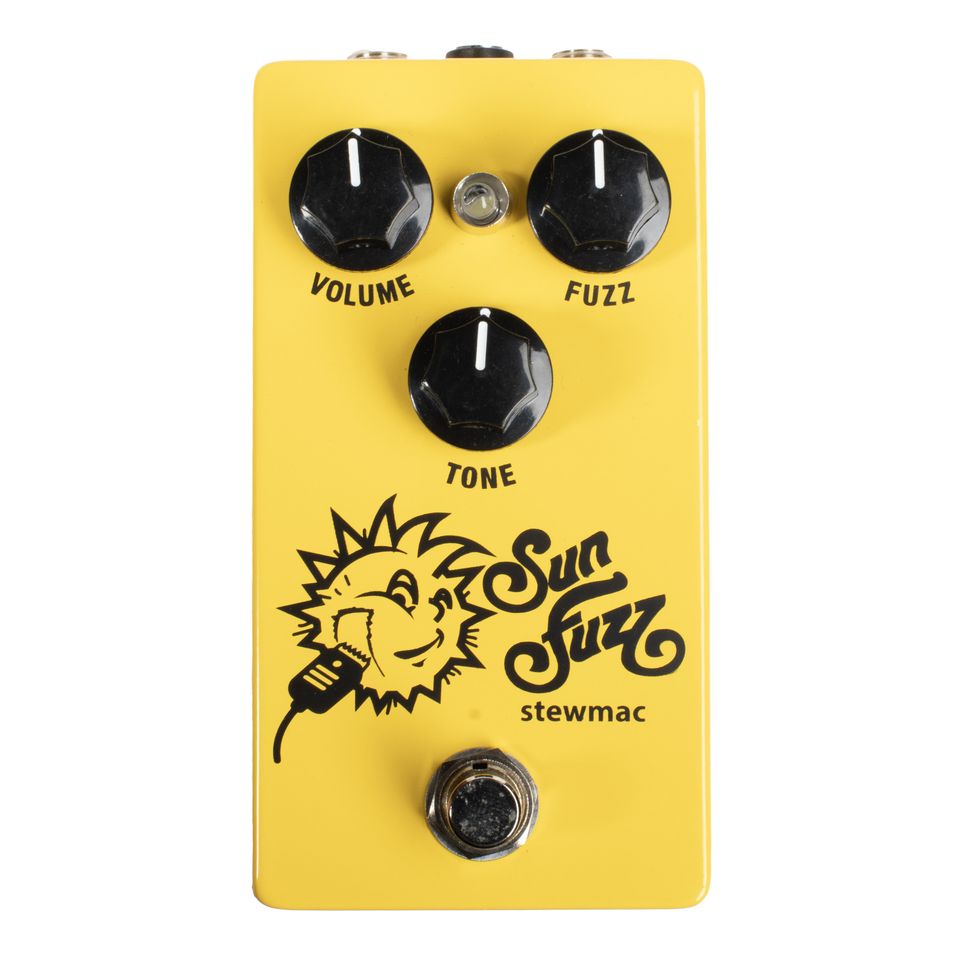
There have been countless replicas and reimaginations of the classic Fuzz Face pedal. StewMac’s Sun Fuzz gives you the control and tone shaping you've always wanted from the originals, and it’s a must-have for fans of Hendrix, Clapton, or Gilmour’s tone.
This circuit is one of the foundational tones for electric guitar, but the germanium powered originals can be hard to control and don't play nice with many pickups and amps—even temperature can completely change the tone! To create a more predictable, controllable, reliable tone, we've swapped the germanium transistor for a silicon BC-108, giving the pedal a brighter tone, more gain, and enhanced touch sensitivity.
Priced at $99.99, the Sun Fuzz is a no-brainer for fuzz fans who don’t want to shell out $200+ for the originals. Key features include:
- Improved bias control and tone shaping compared to the originals.
- Silicon BD-108 transistor.
- Versatile fuzz with simple controls for volume, fuzz, and tone.
- Sounds great with humbuckers, single-coils, and P-90s alike.
Two Kings Boost Dual Overdrive
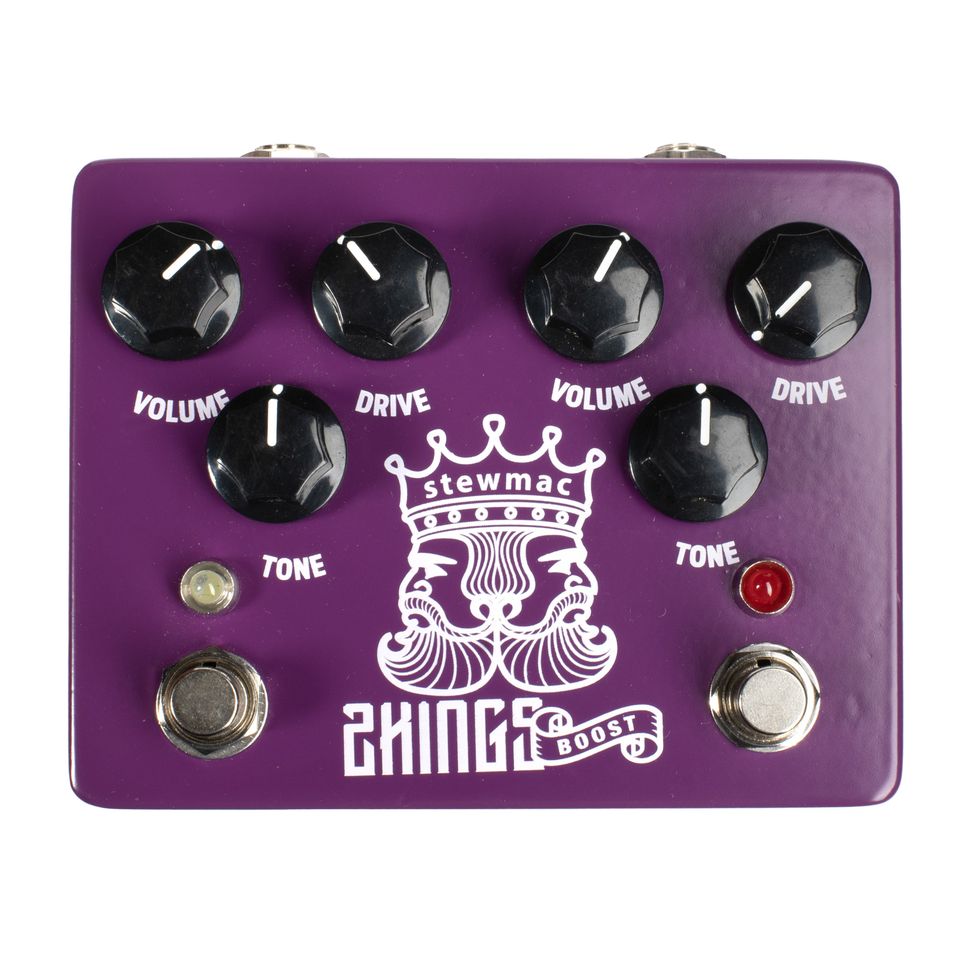
Inspired by one of the most sought-after dual overdrives on the market, players like John Petrucci, Gary Clark Jr., Samantha Fish, and Warren Haynes have raved about the originator of this circuit, the King of Tone. Now, you no don’t have to wait to add this circuit to your rig. StewMac’s Two Kings is transparent but still warm and gritty, with a full range of frequencies available—no matter the setting. It won't overpower the unique tone of your guitar and amp—it just makes it better.
The Two Kings is actually two pedals in one, with selectable boost and distortion through internal dip switches. The two sides of the pedal are completely independent—it's easy to find the sweet spot for each side. With knobs for gain, volume, and tone you can get anything from simple boost, gritty overdrive, and even distortion in a flash. If you want to go deep, you can further tailor the sound with the internal controls for infinite tone tweaking.
Priced at $199.99, the Two Kings is an affordable and authentic alternative to the pricey, hard-to-get original. Key features include:
- 2-in-1 pedal.
- Maintains core tone of guitar and amp.
- Effortlessly provides boost, gritty overdrive, and distortion.
Lightcycle Phasor II
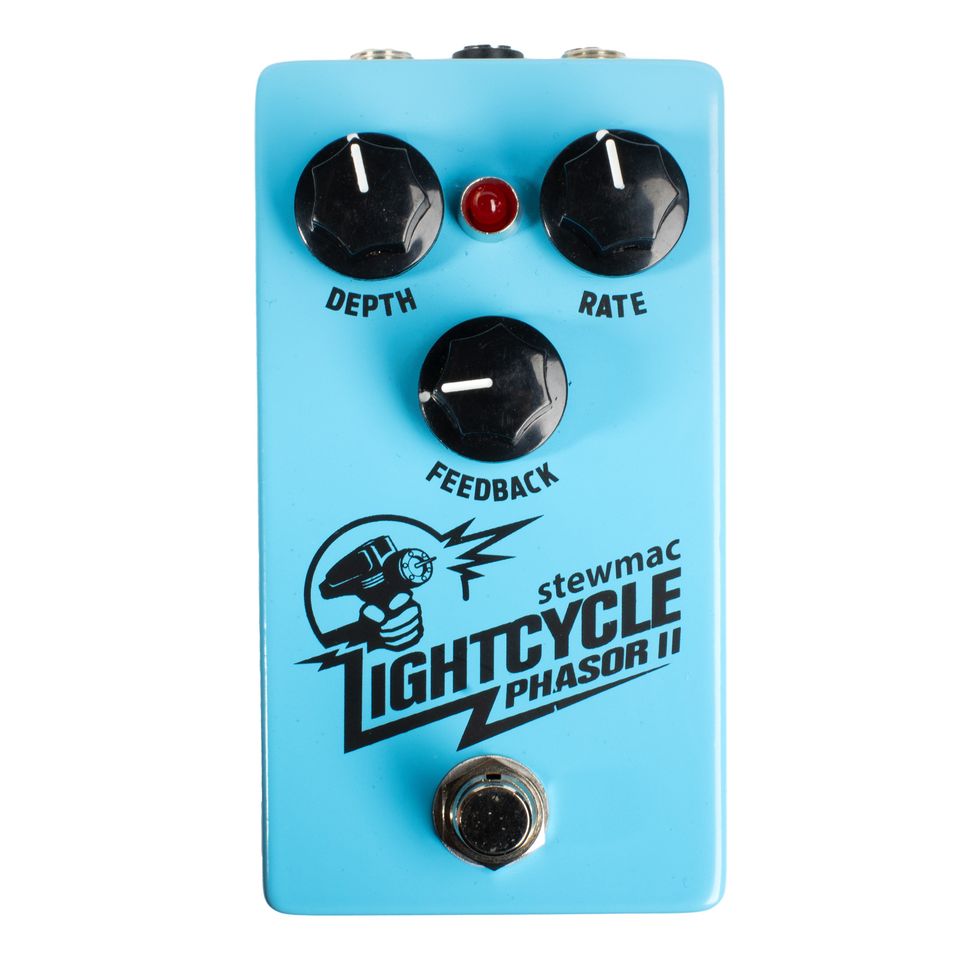
This isn’t just another phase shifter—it’s the unmistakable sound of deep, liquid movement that defined an era. Inspired by the MuTron Phasor II from the 1970’s this studio-quality, all-analog optical phase circuit set the gold standard for smooth, sweeping modulation. StewMac has recreated this timeless classic to bring your tone to life with the same lush, organic depth that graced the pedalboards of legends. You can recreate those complicated textures live—from a rotary speaker shimmer to wild spacey soundscapes, every knob twist sparks inspiration. On the front are controls for depth, rate, and feedback, letting you dial in anything from subtle swirl to rapid tremolo and synthesizer sounds. For even more flexibility, two internal controls let you dial in the sweep and intensity of the phased signal.
Priced At $149.99, the Lightcycle Phasor II is an authentic and affordable alternative to the original. Key features include:
- Studio-quality optical phaser.
- Controls for depth, rate, and feedback.
- Two internal controls to adjust the sweep and intensity of the phased signal.
Ghost Drive
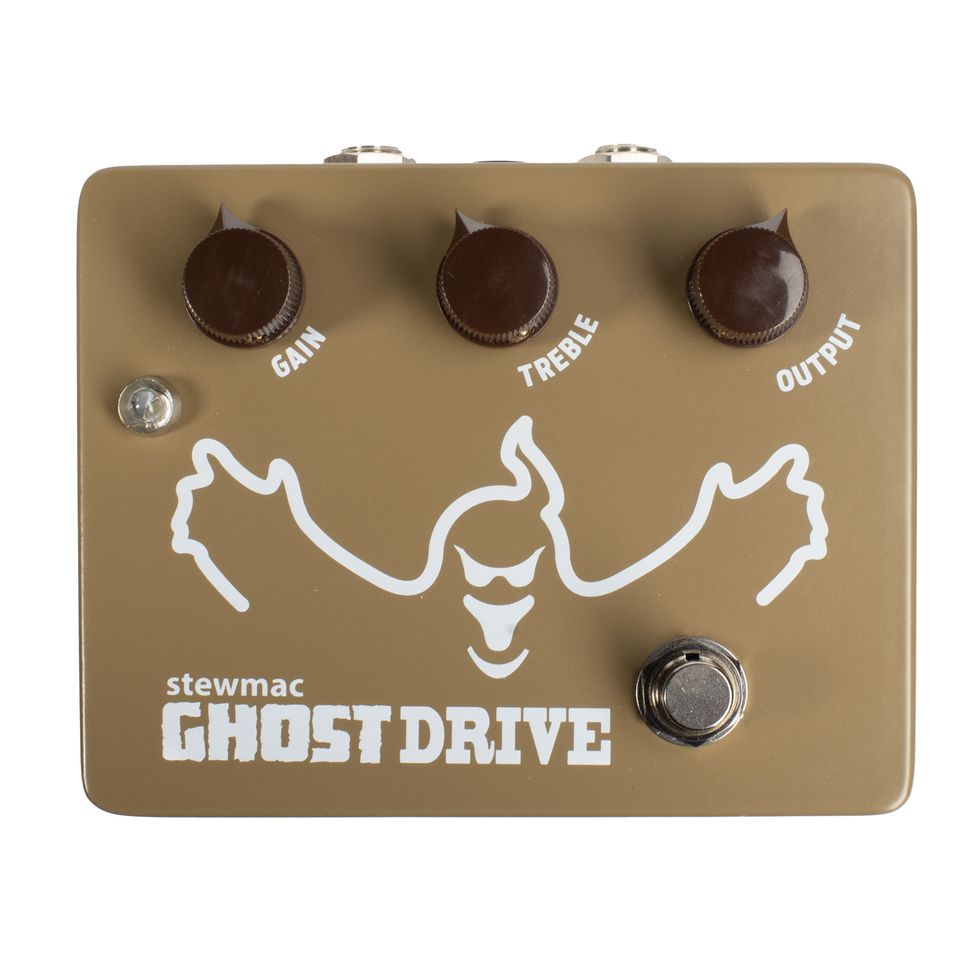
Not just another “klone”, the StewMac Ghost Drive pedal is the closest to the famed Klon Centaur Professional Overdrive we’ve ever heard. StewMac scoured the globe to source the nearly impossible to find (electronically identical) 1N34A germanium diodes that many claim were the heart and soul of the mojo behind the original Klon. Also, unlike so many modern klones that rely on surface mount components, the Ghost Drive is pure old school using through-hole components and traditional solder joints. This gives the pedal the purest tone possible and makes it a true match to the originals. The Klon was made famous by countless players like Joe Perry, Mike McCready, Joe Bonamassa, John Mayer, Nels Cline and more, but at more than $5,000 for a vintage original the StewMac Ghost Drive Pedal
This pedal is extremely easy to use: just gain, treble, and output. The gain is where the magic is by adding sweet saturation and harmonics while retaining the character of your amp. The treble acts as a boost or cut, allowing you to dial in the perfect mid-range for your tone.
Priced at just $149.99, the StewMac Ghost Drive provides a nearly identical tone for just a fraction of the price of the originals. Key features include:
- Through-hole components and traditional solder joints just like the originals.
- The electronic identical 1N34A germanium diodes in the originals.
- Works great as a clean boost as well as a transparent overdrive.
- Buffered bypass.
For more information about StewMac’s new line of pedals visit stewmac.com
Now Available: UAD Shadow Hills Mastering Compressor Class A and Maag EQ4 MS Plug‑Ins
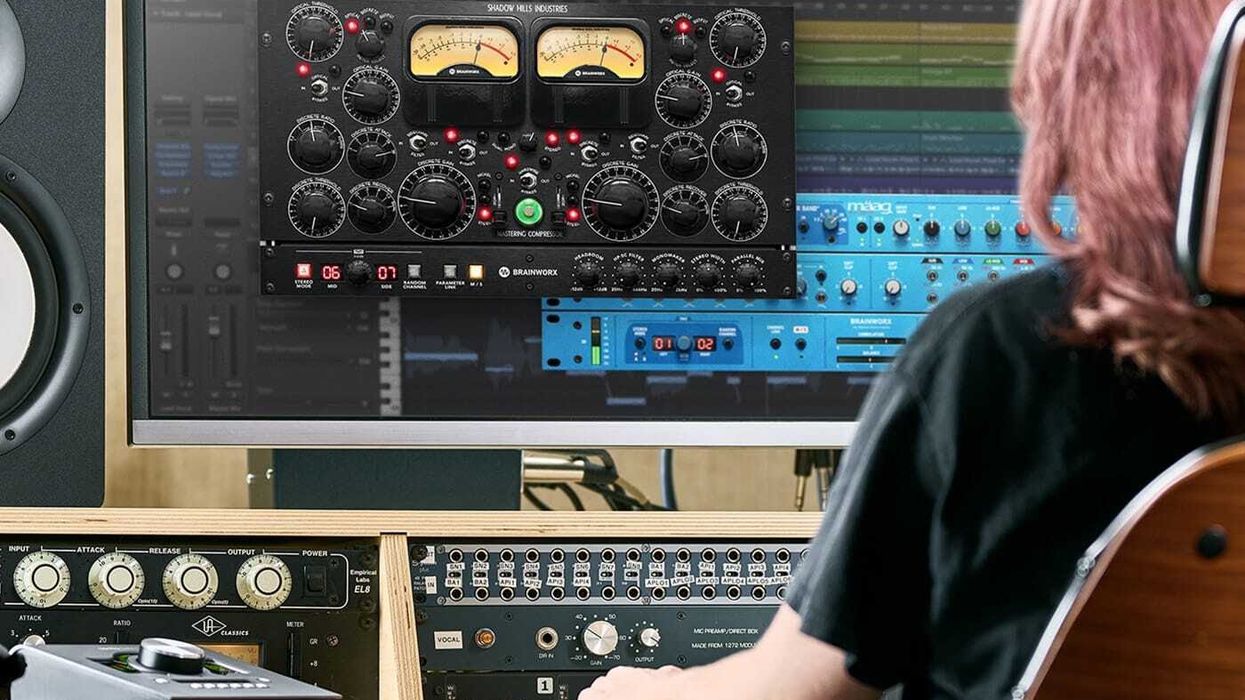
Universal Audio, a worldwide leader in audio production tools, today announced the release of the Shadow Hills Mastering Compressor Class A and Maag EQ4 MS plug‑ins. As a part of the Apollo and UAD v11.8 software update, these plug‑ins deliver enhanced sonics, with new features and workflows for modern music producers and engineers, or those looking to upgrade their current Shadow Hills or Maag plug‑ins.
UAD Shadow Hills Mastering Compressor Class A – $169 USD
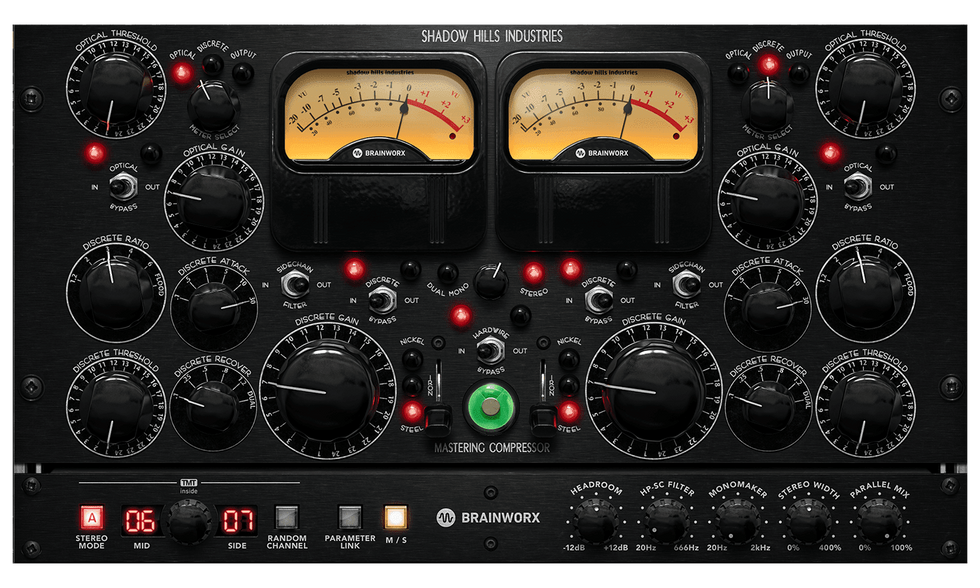
“Shadow Hills Class A and Maag EQ4 MS give music creators access to two rare and unique sounds in the UAD catalog,” says Lev Perrey, VP of Product at Universal Audio. “Beyond the updated UI, they add entirely new sonics and workflow capabilities, expanding what’s possible for customers working with Apollo interfaces and UAD hardware.”
The Shadow Hills Mastering Compressor Class A plug‑in is a meticulous emulation of the legendary “Red” edition hardware — of which only 50 units were ever built. It delivers the coveted dual‑stage optical and discrete compression stages, plus switchable Nickel, Iron, and Steel output transformers so you can dial in open and airy detail to thick, saturated tone.
Sonically enhanced with Tolerance Modeling Technology by Brainworx (TMT), the updated Shadow Hills UAD plug‑in features the subtle channel‑to‑channel variations of the real analog gear, giving mixes added depth and realism. Customers can also access powerful features including Mid/Side processing, Stereo Width control, Mono Maker, Parallel Mix, scalable UI, and more — going far beyond the original hardware.
Shadow Hills Mastering Compressor Class A - Key Features
- Updated version of rare Class A dual‑stage optical and discrete compressor plug‑in
- TMT technology by Brainworx adds subtle channel‑to‑channel variations for greater analog realism
- Switchable Nickel, Iron, and Steel output transformers for unique tone shaping
- Enhanced Class A circuitry with 1–3 dB hotter presence than the original UAD plug‑in
- Plug‑in only features: Mid/Side, Parallel Mix, Stereo Width, Mono Maker, Sidechain Filter
UAD Maag EQ4 MS — $129 USD
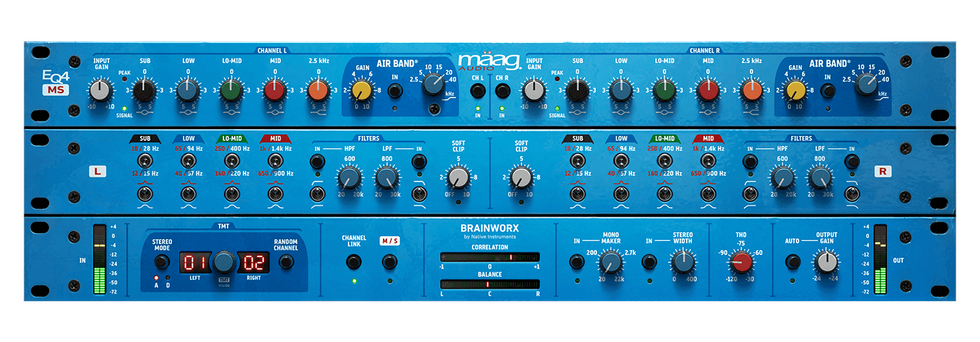
The Maag EQ4 MS plug‑in brings life to a classic UAD plug‑in title. Along with its iconic Air Band, the new version features Mid/Side processing, expanded frequency choices, selectable Q values.
Ideal for adding presence to vocals and instruments, the Maag EQ4 MS now brings extra clarity and depth to mixes thanks to TMT technology by Brainworx — which captures the real‑world channel variations that add analog realism unlike other matched digital EQs.
Maag EQ4 MS - Key Features
- Updated edition of the legendary EQ4 plug‑in with expanded sonics and flexibility
- TMT technology by Brainworx captures natural channel‑to‑channel differences for extra width and dimension
- Iconic Air Band delivers transparent, musical high‑end sheen for vocals and instrument
- Mid/Side processing tools for precise control of stereo image and depth
- Expanded frequency options and selectable Q values for refined tone shaping
Also included in the UAD v11.8.1 update, MIDI Learn is now available for all UAD DSP plug‑ins, giving customers hands‑on control of plug‑in parameters with compatible MIDI controllers. With a simple click, touch, move workflow, music producers working in Apollo studios with UAD plug‑ins can map knobs and faders in seconds — eliminating tedious menu diving.
Pricing & Availability
- The Shadow Hills Mastering Compressor Class A plug‑in is available for $169 (new customers) or $39 (upgrade price).
- The Maag EQ4 MS plug‑in is available for $129 (new customers) or $39 (upgrade price).
- Both plug‑ins, along with MIDI Learn functionality, are included in the Apollo & UAD v11.8.1 software update, available September 4, 2025.
Learn more about Shadow Hills Mastering Compressor Class A:
uaudio.com/products/shadow-hills-mastering-compressor-class-a
Learn more about Maag EQ4 MS:
uaudio.com/products/maag-eq4-ms
Learn more about UAD Plug‑Ins:
uaudio.com/collections/uad-plugins
Download images and press materials:
Vox V863-CA Review
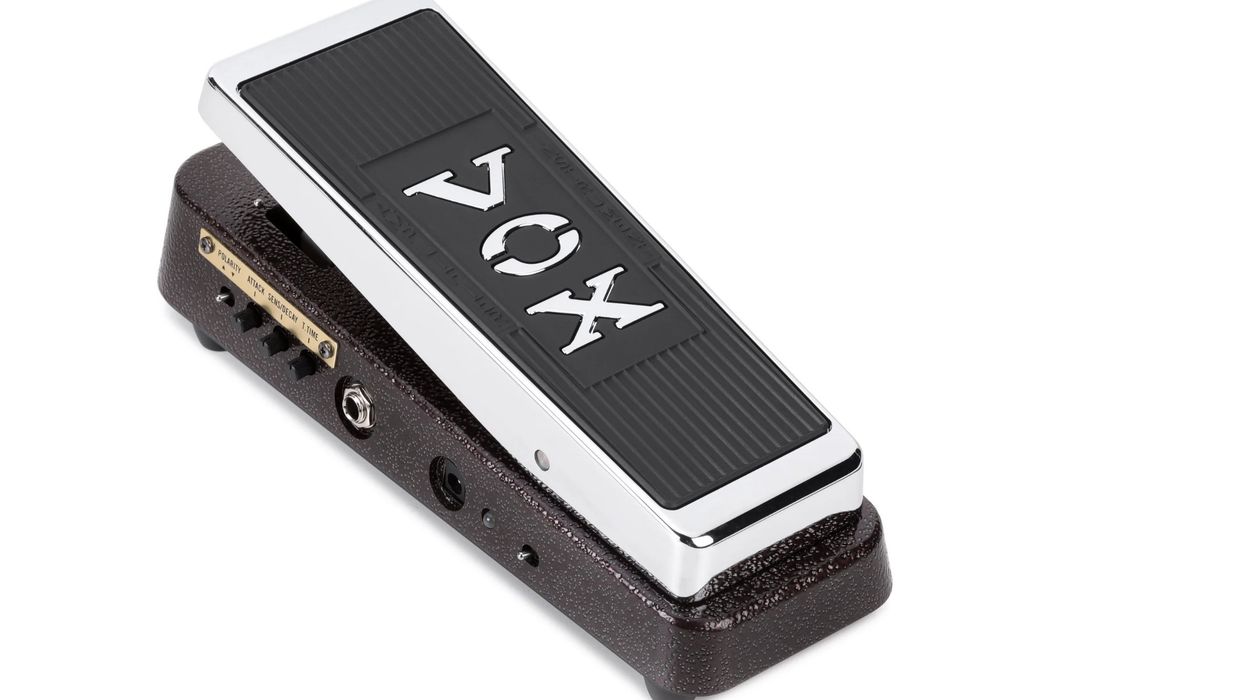
A 3-in-1 wah, envelope follower, and envelope controller that opens up a huge range of filtering possibilities.
As an avid—perhaps rabid—musical psychedelicist, I’ve had a lot of wah in my life. Maybe too much. In recent years, I seem to have had my own personal version of the rock world’s 1968 epiphany, where everyone ditched their wah and fuzz, moved to the country, and put Music from Big Pink on constant replay.
Recently, though, I’ve been in touch with my wah side again—this time by way of JJ Cale’s chilled out swells and Curtis Mayfield’s mellower wah flourishes. And through these applications of treadle-actuated filtering, I’ve rekindled my love for the more psychotic side of the effect. Vox’s V863-CA will happily wind along either the gentle path or the hard road. It has a nuanced filter taper that makes slow, focused sweeps sound sweet and vocal, and it responds to quick-twitch moves with precision. But the real magic in the V863-CA is its combination of envelope generator (auto wah) and envelope follower functions, as well as its ability to switch between wah and the two filtering modes merely by lifting your foot from the treadle.
It Just Takes A Touch
You can only use either the envelope generator/wah combination or the envelope follower/wah combo at any given time—a small price to pay for the versatility at hand here. You can, however, select between those two modes with a small mini toggle on the lower left side of the enclosure—which, incidentally, seems well out of the way of accidental triggering. There is a third position for wah only, which is useful for accessing cocked wah tones. But you can switch any of the effects into bypass mode with a click in the toe-down position.
Vox’s V863-CA will happily wind along either the gentle path or the hard road.
Inspired by Dead and Company’s recent shows celebrating the Grateful Dead’s 60th anniversary, I explored the envelope follower section of the V863-CA in honor of Jerry Garcia. The V863-CA performs admirably in this capacity. Using the polarity switch, you can shape the filter’s reaction to a dynamic trigger. In one mode the filter’s voice opens with a “wow”-like tonality; in the opposite polarity it yields a snappier effect. It’s a pretty sweet-sounding envelope filter, too—particularly in the more open, vowelly, Garcia-like mode. The sensitivity control, which governs the filter’s reaction to picking dynamics, isn’t the most nuanced, and I preferred to keep the sensitivity wide open and control the sound via my picking and guitar volume (which can dull the dynamic response if you turn down too much). Still, the biggest thrill of using the envelope follower mode was the ability to launch from a chilled, quacky, Garcia run to Eddie Hazel “Maggot Brain” intensity just by putting my foot on the treadle. This is a genuinely inventive feature that will open up possibilities to players outside the psychedelic sphere.
The envelope generator, or auto wah function, can be shaped with both the decay control and the attack knob, which manipulate the filter’s reactivity. (Both knobs have useful center detents). Between the two controls you can craft syrupy response for spacey, slow jams (delicious with loads of delay) or snappy, funky interactions that will keep up with rapid-fire Nile Rodgers-style licks.
At $279, Vox’s Vietnam-made V863-CA seems expensive until you dig deep into its bag of tricks. And though it might appear specialized, I had little problem finding novel uses of the combination effects that broke the funky and acid-fried wah molds and led to more unusual ends. But the coolest part of the V863-CA experience remains the ability to seamlessly move from wah to filtering functions simply by lifting one’s foot. It’s a smart way to shift between verse, chorus, and solo segments without tap dancing between multiple pedals. The same functionality can generate dramatic changes in mood and dynamic, inspiring whole compositions and arrangements. In that respect, the V863-CA delivers value in abundance.
Red Light Fright
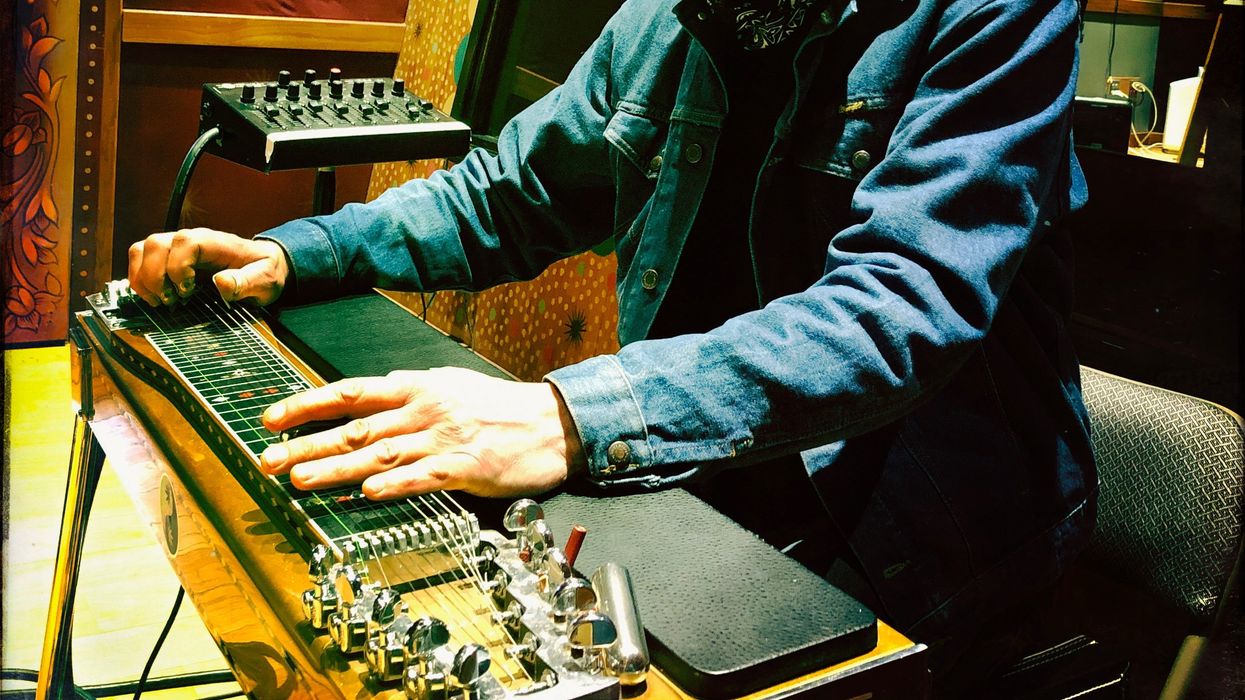
In the 1999 cult classic Mystery Men, Invisible Boy has a superpower that’s as hilarious as it is relatable: He’s invisible, but only when no one’s looking. The moment eyes are on him, he’s just a kid in a cape, exposed and ordinary. Musicians, doesn’t that hit home? When it’s just you and your guitar, the music flows like a river—raw, unfiltered, alive. But flip on the studio’s red light or face a sea of cell phones at a gig, and that river can dry up fast. It’s the red light paradox: The act of capturing inspiration often chokes it.
Players like Marcus King, Masayoshi Takanaka, and Tom Bukovac seem to live in that effortless zone, channeling endless streams of soulful licks. Alone in a room, you might tap into that, too—those late-night jams where riffs cascade and ideas feel infinite. No stakes, no judgment. Only creation. But in the studio, that red light is a judge with a gavel. Every note feels etched in stone, ready for eternal scrutiny. The ticking clock, the producer’s glance, the knowledge that a single take could live forever—it’s enough to stall the flow.
I’ll never forget filming a Rig Rundown with Thom Bresh in 2020. Thom was an absolute legend with talent that drove an incredible seven-decade career. Before we started, I said, “Hey Thom, want to play something going into the interview?” He paused, grinned, and replied, “Been playing my entire life, but the minute somebody asks me to play, I got nothing. My mind goes blank.” If a giant like Bresh could feel that pressure, what hope is there for the rest of us mere mortals? It’s proof that the red light doesn’t discriminate.
“It’s not about nailing every note; it’s about capturing something true.”
Live music, though, is a different beast. There’s freedom in the fleeting moment. The crowd’s energy, the vibe with bandmates, the knowledge that a flubbed note vanishes by the next song—it all invites risk. I’ve seen players, myself included, get bold onstage in ways we’d never try in the studio. You’ll stretch a phrase, chase a wild harmony, or lean into a bend that might not land, because it’s yours and it’s gone in minutes. It’s a tightrope walk with a net, letting you attempt crazier tricks.
In the studio, that net’s gone. The red light means evidence—permanent, unerasable. Every take is a potential exhibit in the court of public opinion. (Even onstage now, since a phone clip can haunt you online until our hypothetical ape overlords unplug the internet.) It makes you play it safe. I do it—sticking to solid takes to avoid being “that guy” holding up the session. If the bassist or keyboardist wants another pass, I’m right there—not always because I hate my take, but for insurance. Just in case there’s a gremlin in the mix—a flubbed note, a shaky vibrato, or a phrase that felt cool but now sticks out like a bad tattoo.
That self-consciousness isn’t just about avoiding mistakes; it’s the weight of permanence. Live, a missed note is usually a blip, forgotten by the encore. In the studio, it’s a ghost that could haunt you. I’ve heard players nail a take only to spend hours second-guessing it, not because it’s bad, but because it might not be perfect. And perfection, we all know, kills vibe. The studio’s a paradox: it’s where you immortalize art, but the process can drain its soul.
”That self-consciousness isn’t just about avoiding mistakes; it’s the weight of permanence.”
So how do you beat the red light curse? Some players treat the studio like a live gig—dim the lights, imagine a crowd, or track live off the floor to capture that loose, communal energy. Others prep relentlessly, woodshedding parts so the light can’t rattle them. Bukovac, in a Homeskoolin’ video, talks about playing like you’re “just messing around,” even in high-stakes sessions. Easier for a guy who bleeds licks, but there’s truth there: The less you fear the light, the freer you play. I’ve tried picturing it as a vibe check, not a verdict, but it’s tough when Thom Bresh’s words echo. Even legends go blank under pressure.
Maybe the answer lies in embracing the imperfection the red light exposes. Live, we forgive ourselves because the moment’s gone. In the studio, we must forgive ourselves knowing the moment’s forever. It’s not about nailing every note; it’s about capturing something true. Next time you’re in the booth, staring down that glowing red eye, channel Invisible Boy. Shrug off the gaze and play like no one’s watching. Because the only judgment that matters is whether the music moves you. If it does, it’ll move someone else, too
A Psychedelic Swirl S-style Honors a Lucky Black Cat
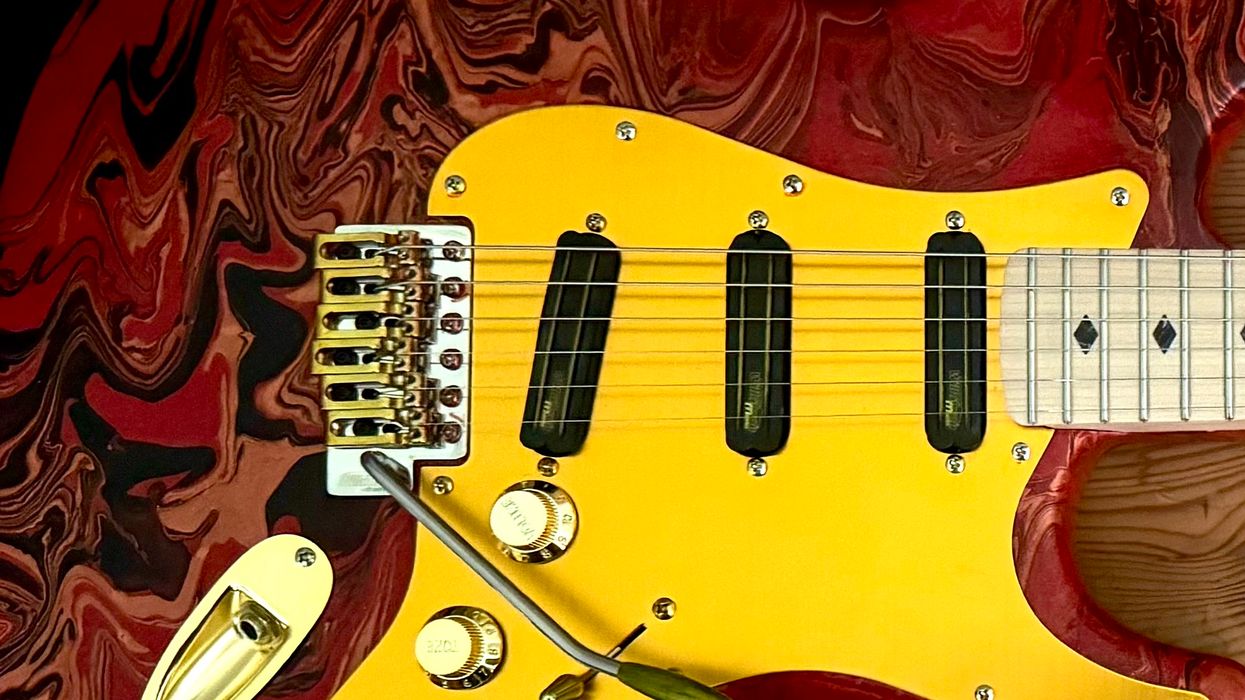
Reader: Cary Cummings
Hometown: Seattle, WA
Guitar: Catocaster
“The problem with cats is they get the exact same look whether they see a moth or an axe murderer.” —Edgar Allen Poe
Leroy had the courage to live on this earth for 19 1/2 years.
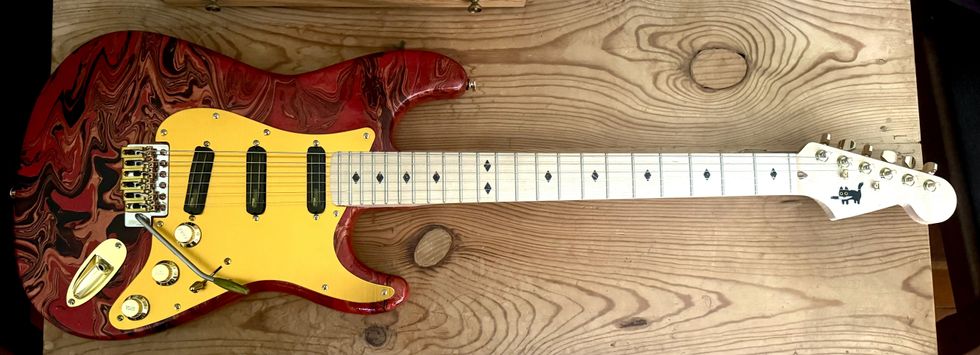
I had no idea what to expect when we arrived at the live animal will-call area at the airport. I knew I was picking up a 12-week-old Burmese kitten. When they brought out his little crate carrier, I was nervous and excited. But when I opened the door to peek inside and greet our new arrival, I saw a shockingly tiny, scared little creature that could fit in the palm of my hand, and I felt so bad that he was put through such an ordeal. He seemed pretty calm about the whole thing.
“Leroy liked flashy things, chaos, and movement.”
At his full-grown eight pounds, Leroy was the patriarch of our household and animal family. Over the course of his days, he lived and played with six different labrador retrievers, outliving three of them. He was everyone’s buddy and tormentor in equal measure. He slept on his bed when he wanted, curled up on a dog’s tummy, or on one of our heads. He loved to play fetch, knock over unattended glasses full of water, and relished a 90 mph sneak attack as we descended the stairs. He loved us, but often reminded us that we really lived in his world and he could take us out at any time. If he had been as big as one of the dogs it would have been terrifying. Sometimes it was terrifying anyway.

I built this guitar to remember and honor Leroy. He liked flashy things, chaos, and movement. He also loved “helping” change guitar strings and occasionally trying to swallow them. This build consists of a S-style poplar body from Ultratouch Guitars in Texas and a Warmoth quarter-sawn S-style neck with a Clapton carve and 6150 frets. I sprayed the body with a primer coat, followed by apple-red satin, and finished it off with Rustoleum red glitter to give it some sparkle. To add interest and movement, and a little chaos, I dipped it into a 32-gallon garbage can filled with water topped with a swirl of Magic Marble paint, finally sealing it in with 10 coats of wipe-on poly.
The finishing touch included an orange anodized pickguard, Wilkenson/Gotoh VSVG tremolo bridge, Wilkenson low gauss, blade style pickups, 250k CTS pots, 0.015 uF ceramic disk capacitors, Gotoh gold tuners, and a dangerous cat decal on the headstock.
I like to imagine Leroy somewhere over the rainbow bridge playing with his friends: Charlie, Dewey, and Olive. I hope to find them again one sunny day. I know Leroy would approve of this guitar and probably give me another sneaky needle-toothed surprise attack to celebrate.
Rig Rundown Best Of: Legendary Gibson ES-335 Stories and Setups
From Tom Bukovac’s first-year ’58 to Larry Carlton’s iconic ’69 and Molly Miller’s well-worn ’78, this PG best-of Rig Rundown celebrates the artists who made the ES-335 their own. Hear Charlie Worsham’s Vince Gill gift story, Tim Pierce’s player-grade philosophy, and Sturgill Simpson’s stage-shaking tones—plus why so many pros trust this semi-hollow classic.
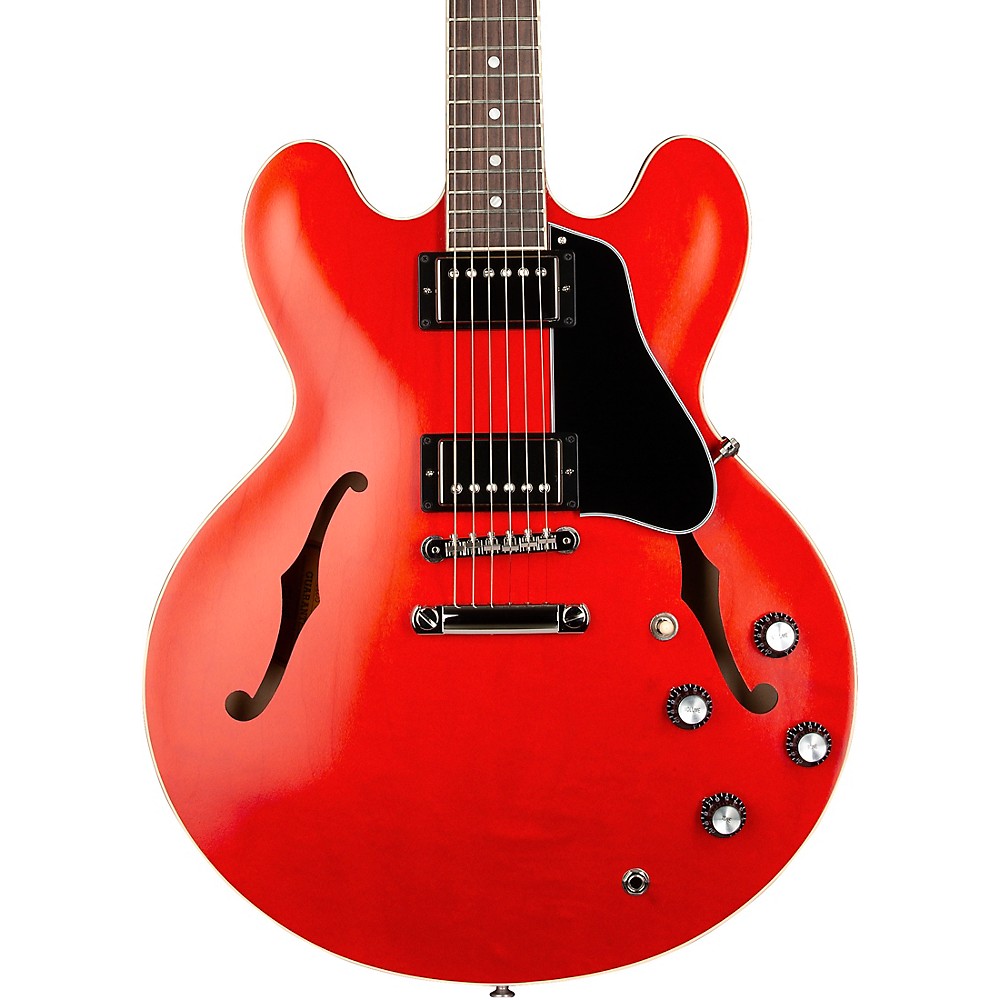
Gibson ES-335 Satin Semi-Hollow Electric Guitar Satin Cherry
Steve Gunn Announces Daylight Daylight; Shares “Nearly There”

Steve Gunn has been at the vanguard of American experimental / guitar-oriented rock music for over a decade. After a trio of acclaimed albums recorded for Matador, Gunn will release his 7th studio record – and first in 4 years – on November 7th.
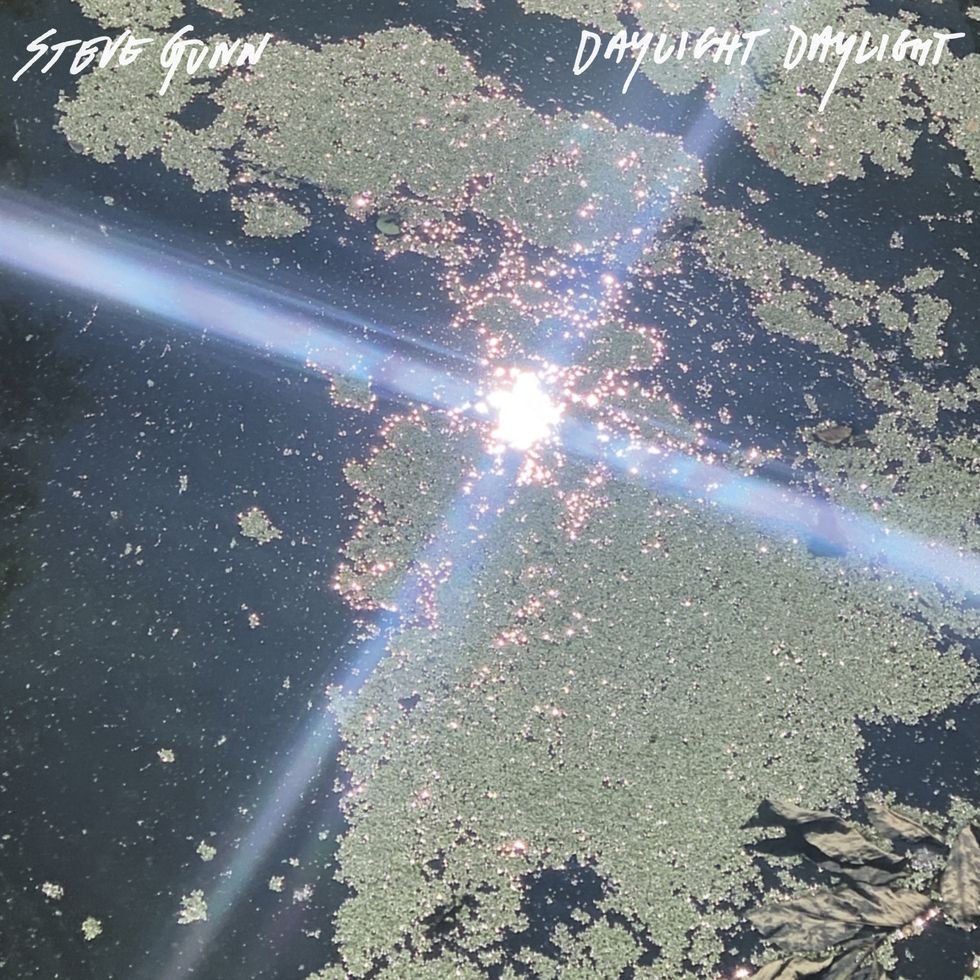
With Daylight Daylight, Gunn wanted to capture something of the intimacy of playing solo, the sense of possibility and discovery that sparks when he sits down to write, while also creating a rich sonic world for the listener to inhabit. Rather than pulling together a band to flesh the songs out, as he’s done on previous albums, he enlisted a single primary collaborator: producer James Elkington, an old friend and longtime collaborator (who also produced Gunn’s 2019 album The Unseen In Between). Elkington is known as a guitarist, but Gunn asked him to contribute arrangements of strings and woodwinds, inspired in part by the music they’ve talked about over the years (ie. Mark Hollis, Ennio Morricone, The Fall, Basil Kirchin) and the evolution of their own relationship making records - both together, and with others. They soon found a fruitful working process for Daylight Daylight: Gunn would record solo demos and send them to Elkington, who had free rein to develop the arrangements on his own. Working primarily out of Elkington’s Nada Studios in Chicago, they would continue adding from there—a whisper of a synthesizer, a guitar overdub, a muted percussion line—but they were committed to the relative spareness of their initial approach. Macie Stewart (violins and viola), Ben Whiteley (cellos), Nick Macri (upright bass) and Hunter Diamond (woodwinds) also contributed. Listen to the album opener “Nearly There” today: noquarter.lnk.to/nearlythere And pre-order Daylight Daylight at the link below: noquarter.lnk.to/daylightdaylight
Tracklisting:
Nearly There
Morning on K Road
Another Fade
Hadrian’s Wall
Daylight Daylight
Loon
A Walk
Gunn will tour the UK and Europe in October and November and is announcing a run of US dates today.
Sept 11 – Chicago, IL @ Sound & Gravity Festival
Sept 25 – Kingston, NY @ Tubby’s Oct 23 - London, UK @ St. Mathias *
Oct 24 - Glasgow, UK @ Hug and Pint *Oct 25 - York, UK @ The Band Room *Oct 26 - Shropshire, UK @ Firefly *
Oct 28 - Stockholm, Sweden @ stadsgardsterminalen
Oct 29 - Göteborg, Sweden @ Pustervik
Oct 30 - Oslo, Norway @ Bla
Oct 31 - Kristiansand, Norway @ Dirty Old TownNov 1 – Stavanger, Norway @ Folken
Nov 2 – Bergen, Norway @ Kunsthall
Nov 9 - Sétubal, Portugal @ Forum Luisa TodiNov 14 - Dranouter, Belgium @ Dranouter
Nov 15 - Turnhout, Belgium De Warande
Dec 3 – Philadelphia, PA @ Johnny Brenda’s
Dec 4 – Baltimore, MD @ Metro
Dec 5 – Raleigh, NC @ King’s
Dec 6 - Washington, DC @ DC9
Dec 10 – Portsmouth, NH @ The Press Room
Dec 11 – Portland, ME @ Space
Dec 17 – New York, NY @ Le Poisson Rouge
Jan 1 – Sawyer, MI @ Out There
Han 14 – Seattle, WA @ The Triple Door
Jan 15 – Vancouver, BC @ The Fox Cabaret
Jan 17 – Portland, OR @ Polaris Hall
Jan 20 – San Francisco, CA @ Café Du Nord
Jan 21 – Santa Cruz, CA @ The Crepe Place
Jan 22 – Ojai, CA @ Deer Lodge
Jan 23 – Los Angeles, CA @ The Lodge Room
Jan 25 – Pioneertown, CA @ Pappy’s & Harriet’s
*w/ James Elkington
Tame Impala Releases New Single “Loser”
Today, Tame Impala (Kevin Parker) unveils “Loser,” the second song of this new era. LISTEN HERE. The track continues Parker’s fearless exploration of rhythm, texture, and sonic experimentation, building on the meticulous studio approach that has defined his career. The single is accompanied by a music video directed by KRISTOFSKI, and starring actor/musician Joe Keery (Stranger Things, Fargo). Watch the clip HERE:
Prior to today’s release, Parker gave fans a taste of what’s to come with the release of his sprawling, drum-beat heavy “End of Summer.” It drew listeners back to the acid house summer of ’89, free parties of the mid-90s, and Australia’s bush doofs in outback paddocks. “Loser” continues Parker’s journey into new sonic territory, layering hypnotic rhythms and textures that push Tame Impala’s sound ever forward. Drawing from a rich history of dance music, his work transforms the imagined past into a sound that feels both present and eternal, reaffirming Tame Impala as one of modern music’s most visionary acts.
Kevin Parker has emerged as one of the most influential voices of the last decade. A singular artist renowned for carving out a distinct sound all of his own, Parker crafts transcendent genre-bending sonic landscapes playing every instrument and acting as writer, producer, mixer and engineer on his projects. He has been nominated for four GRAMMY awards with one win for his collaboration with Justice on 2024’s “Neverender.” In his home country of Australia, he’s racked up an impressive 13 ARIA Awards and 27 Nominations. He’s won the BRIT Award for Best International Band and scored nominations for two Billboard Music Awards and an American Music Award. Tame Impala has had numerous US Alternative Radio Top 10 songs including two #1’s for “Lost In Yesterday” and “Is It True.” Tame Impala’s “The Less I Know The Better” is part of the Billionaires Club with over 2 billion streams and the project has racked up numerous gold and platinum certifications globally.
Tame Impala has headlined festivals and arenas around the world and released four full length albums - InnerSpeaker, Lonerism, Currents and his most recent album The Slow Rush. The Slow Rush landed at #1 in multiple territories and was his highest charting album to date in both the US and UK, with 14 top 10 chart positions around the world. As a writer and producer Parker has collaborated with Dua Lipa, The Weeknd, SZA, Lady Gaga, Travis Scott, Mark Ronson, Gorillaz, Thundercat, Kali Uchis, 070 Shake, Rhianna, Miguel, A$AP Rocky and many more.
Jimi Hendrix Sonic Scholar Andy Aledort | 100 Guitarists Podcast
We figure Jimi Hendrix is easily the most discussed guitarist of all time. And at this point, there are probably few, if any, stones left unturned. So for our Hendrix episode of 100 Guitarists, we had to go to the ultimate scholar on Hendrix’s playing to get deep, and luckily we knew just who to call.
Whether you realize it or not, you’ve probably learned at least a song or two from a transcription or lesson by Andy Aledort. A veteran guitar journalist and transcriber whose resume stretches back to the earlier days of guitar magazines, he’s released books and DVDs teaching the secrets behind Hendrix’s playing and continues to post on YouTube. And if that’s not authoritative enough, Andy has not only played with the Band of Gypsys, but he’s one of the guitarists that Buddy Miles and Billy Cox called for the recording of their The Band of Gypsys Return record.
On this episode, Andy walks us through his own experience of Hendrix’s music, plays us some examples, and tells us some stories from the early days of guitar journalism.
Thanks to our Sponsor, Strings by Mail!
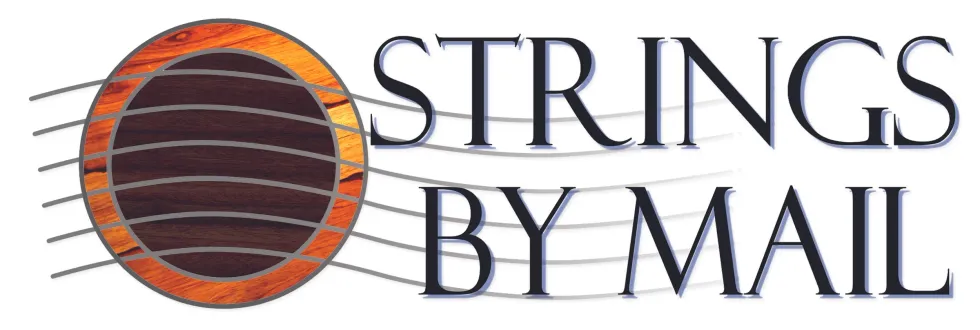
Learn More stringsbymail.com
The Red Light Trifecta
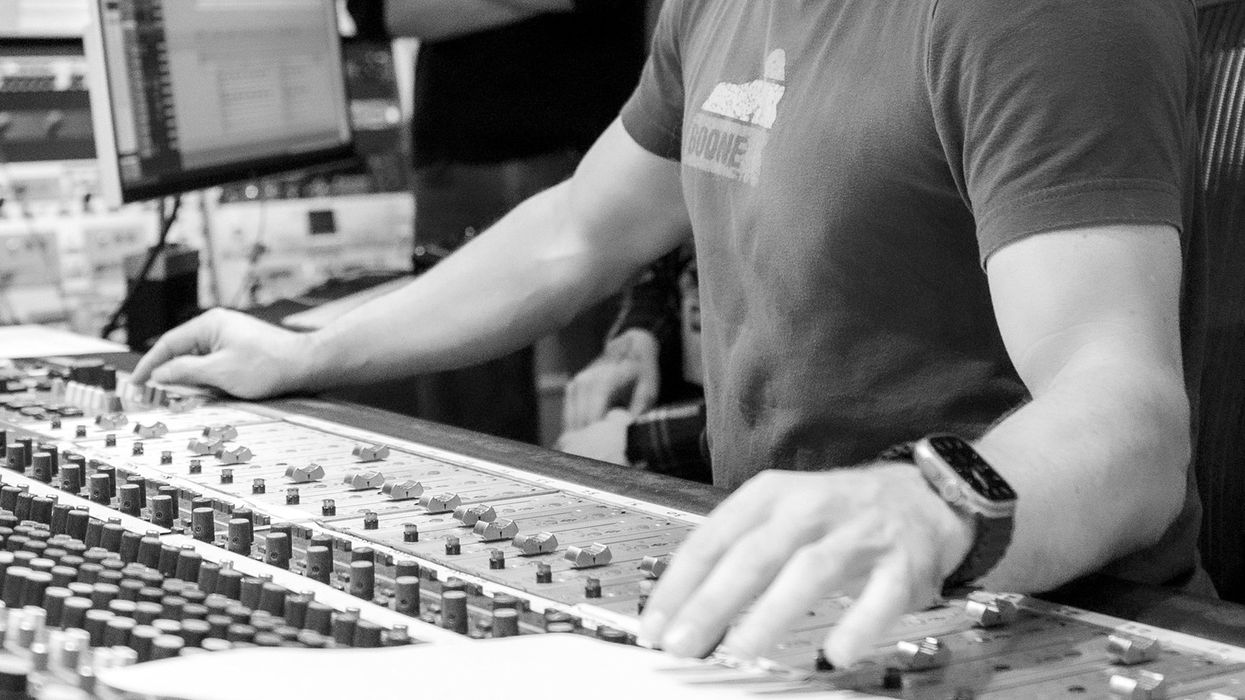
Player feel, mic placement, and your recording room are the real secrets to getting soulful, compelling performances. Spend time understanding them before you push the button.
In a world saturated with plugins, presets, and post-production wizardry, it’s easy to forget the most important part of the recording process. I call it the “Red Light Trifecta.” It’s a simple, powerful concept that can transform your recordings from sterile to soulful—regardless of your gear, your room, or your budget. Tighten up your belts, the dojo is now open.
The Red Light Trifecta refers to three interdependent elements that define every recorded sound: the player (of which the instrument is merely an extension), the microphone (and its placement), and the room. If you’re lacking in any one of these, your recording suffers—not just in fidelity, but in feel. When all three work in harmony, the red light on your recorder becomes a doorway to magic. Below, we’ll explore the steps to achieving this.
1. Feel First, Gear Second
It’s easy to get lost in the gear conversation. The internet is full of passionate debates about preamps, converters, boutique mics, and vintage/new guitars. But none of it matters if the performance isn’t compelling.
When you press record, you’re not capturing a tone; you’re capturing a human being’s interaction with an instrument. You’re capturing intention, emotion, and energy. The touch of a player’s fingers on the fretboard, the timing of a right-hand mute, the bend at the end of a phrase—these micro-decisions are what form the soul of a recording. And they’re specific to that player.
“When you press record, you’re not capturing a tone; you’re capturing a human being’s interaction with an instrument.”
If you’ve ever plugged into someone else’s rig—same guitar, same amp, same settings—you know how uncanny it is that you still sound like you. Conversely, a truly great player can make a pawnshop guitar sound like it came from a boutique luthier’s bench. That’s not mysticism; it’s muscle memory, control, and mindset.
So the first rule of recording is this: Start with the player (even if it’s you)! Are they connected to the music? Are they playing with purpose? No amount of EQ or compression can fake that.
2. The Mic: Placement Over Price Tag
If the player is the heart of the performance, the mic is the conduit. There are thousands of microphones out there; some with reputations so mythic they practically glow in the dark. But a great mic in the wrong place will still result in a lousy recording. Conversely, a modest mic in the right spot can yield professional, even breathtaking results.
Mic placement is where your ears matter more than your eyes. It’s about experimenting, listening, and adjusting. Moving a mic an inch can dramatically change the tone—less boom, more clarity, tighter low end, softer transients. You’re not just pointing a mic; you’re sculpting a sound at the source.
Want a quick way to test your placement? Record a short passage, then move the mic slightly and record again. Compare. Listen to not just the tone, but the space, the balance, the emotional impact. Don’t be afraid to break rules or try unconventional setups. Your job isn’t to copy someone else’s sound—it’s to find the best version of yours.
Remember: It’s very easy to make an expensive mic sound cheap. But with care, it’s also possible to make a budget mic sound exceptional.
3. The Room: The Invisible Instrument
The third member of the trifecta is the most misunderstood—and the most revealing: the room. Every space has a sound, whether you’re aware of it or not. Some spaces are flattering. Some are brutal. But all of them are recorded.
Think of the room as your invisible instrument. It contributes resonance, reflections, and tone. It shapes the reverb tail, the attack, and the decay. If the room is boomy or boxy, your track will sound that way—even before you add any processing. If it’s too dry, you might find your recordings feel lifeless or anemic.
That doesn’t mean you need a world-class studio with floating floors and golden ratios. It means you need to understand your space. Clap your hands. Walk around while playing. Record from different spots. Learn what your room wants to do naturally and work with it, not against it.
Sometimes, the best solution is to change the instrument’s location by a few feet. Or use furniture as gobos. Or hang a blanket. Or lean into the room’s quirks and let them define the character of the track.
The Trifecta in Action
When all three elements align, you get a vibe. You get a performance that resonates emotionally, and sonically. And in the end, that’s what we remember: not the mic model or plugin chain, but how the music made us feel. Until next month, namaste.
Strange Audio The Eloise Review
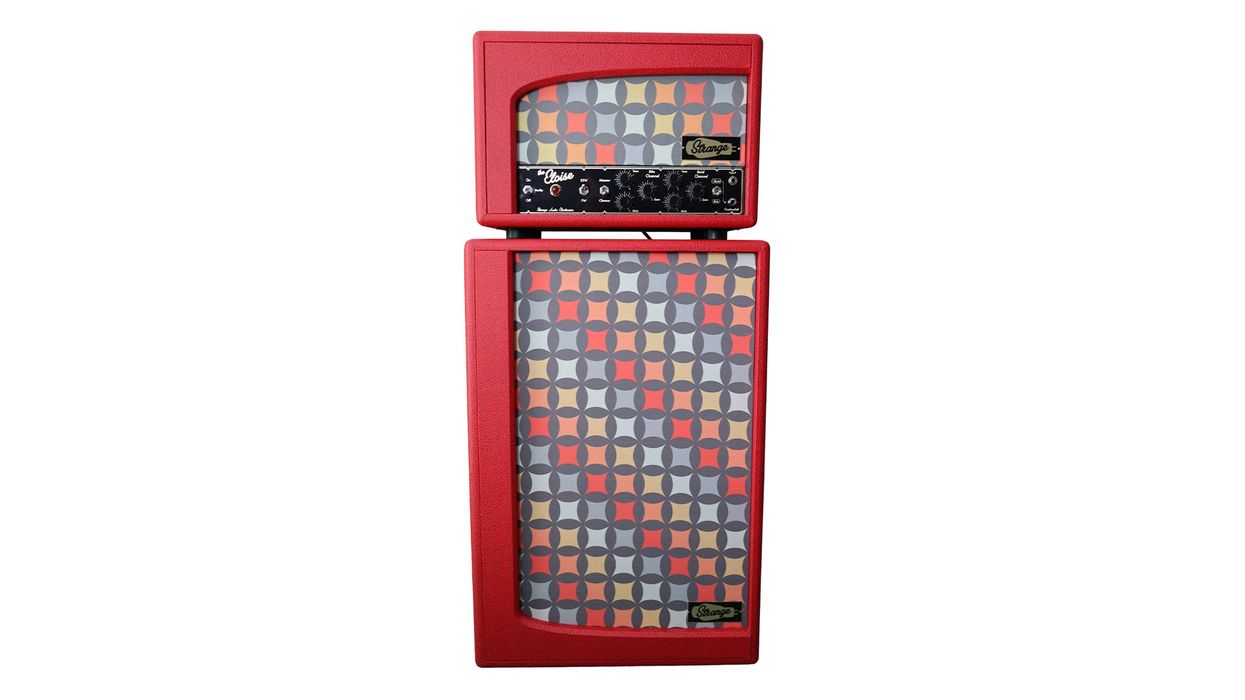
Bold aesthetics and simple but flexible controls make this extroverted 2-channel amp a star.
When it comes to aesthetics, most modern amp design has been lacking for a long time. Go way back to the middle of the 20th century, and you’ll find amps with serious flair. I’m talking about cute little vintage lap-steel combos cranked out by Valco for brands like Oahu, mid-mod-styled early-’60s Gretsches, short-lived watermelon-and-tree-bark ’50s Ampegs, and Fender’s early woody amps, which presaged the bachelor-pad era. By the mid ’60s or so, amp designs coalesced into an assortment of black boxes and have, with some exceptions, remained that way.
When Philly-area amp tech Josh Strange started building his own Strange Audio combos, their candy-colored cabs and technicolor grilles quickly caught the eyes of the Instagram set. The sheer variety of offerings, from grille-cloth options that range from floral to cloud-cover to cowboy, had some of us non-builders wondering, “Has it really been possible to make an amp look this cool all this time!?”
Strange’s latest, The Eloise, comes in a head-and-cab form factor that is stunning. More importantly, Strange’s knack for design goes well beyond the visual. The Eloise’s original circuit design, with switchable preamp tubes and a unique EQ, meets the demands of both players who want a straightforward plug-and-play amp and those who need to capture a wide range of styles or prefer a pedal platform scenario.
Outside the Box
The 35-watt Eloise head is eye-catching for its red vinyl covering and multi-colored starburst grille-cloth, but also for its more subtle but still noticeable control set. There are a pair of triangularly arranged control sets for the bite and bold channels, each of which include tone, gain, and mid knobs. The channels are selectable via a switch on the panel or a footswitch. There’s also an attenuator that brings the power down to about 7 watts, and a 3-way meaner/cleaner/both switch.
The Eloise is ruggedly constructed using top-notch components, including Soursound transformers, and capacitors from Jupiter, Vishay, and F&T. Strange offers matching cabs in 2x12 and 2x10 configurations. I demoed the 2x12, which was loaded with a pair of Weber Legacy Series ceramic speakers.
A pair of 6L6s power the fixed bias circuit, and there’s a GZ34 tube rectifier. Channel switching determines preamp tubes, however. The bold channel uses an octal 6SL7, delivering a robust voice with deep lows, warm mids, and rounded highs. The bite channel utilizes a 12AX7 for a brighter, more cutting high-mid voice. Within each channel, there’s a wide range of tones to explore via the tone control and a unique mid control. The tone knob controls high/low balance, while the mid knob sweeps the midrange voice from scooped to boosted.
Boosted and Balanced
Within each channel, the tone, mid, and volume controls work in conversation with each other, not unlike the tone and volume controls in a tweed Fender, which balance lows, highs, and mids, but also push the circuit to a saturated, overdriven state. As such, I spent lots of time with all three controls pretty near to full-on, manipulating the amp with my guitar volume or playing dynamics.
The meaner/cleaner/middle switch fine tunes output by adding or subtracting negative feedback and a preamp stage bypass cap. Cleaner selects negative feedback with no bypass cap, offering the most headroom; middle offers a medium amount of gain with neither negative feedback nor the bypass cap; and meaner has the least headroom and delivers the most overdrive by adding the bypass cap.
Between these options, the voicing of each channel, and the versatility of each channel’s controls, I dialed up a very wide range of tones. I could find saturated, cutting lead sounds using the bite channel in meaner mode and cranking all three controls, or throaty, neck-pickup tones with the bold channel in cleaner mode, the mids in the upper range, and the gain pulled back to about 60 percent.
Since The Eloise is a cool 35 watts, the natural overdrive is loud enough to hang alongside a rock rhythm section, but not so loud that you’ll get kicked out of the band. And there’s enough headroom that The Eloise can serve as a pedal platform and deliver effect-driven distorted and fuzz tones. The attenuator is effective, too, for keeping overdriven tones ripping without sacrificing tone at lower levels.
The Verdict
The look of The Eloise—and the entire Strange Audio line—helps set a high bar for amp style, and hopefully more builders will take note. Its unique control set and approach to channel voicing is compelling, and the interactivity between the controls gives it a wide range of tone options that are fun and intuitive to explore.
At 35 watts, The Eloise hits a sweet spot for those who want to push their amp while keeping volume manageable. Ultimately, Strange strikes a nice balance between familiar 6L6 territory and a novel approach to how to widen the sonic playing field.
New Flat Patch Cables Join Gator Cableworks’ Composer Series
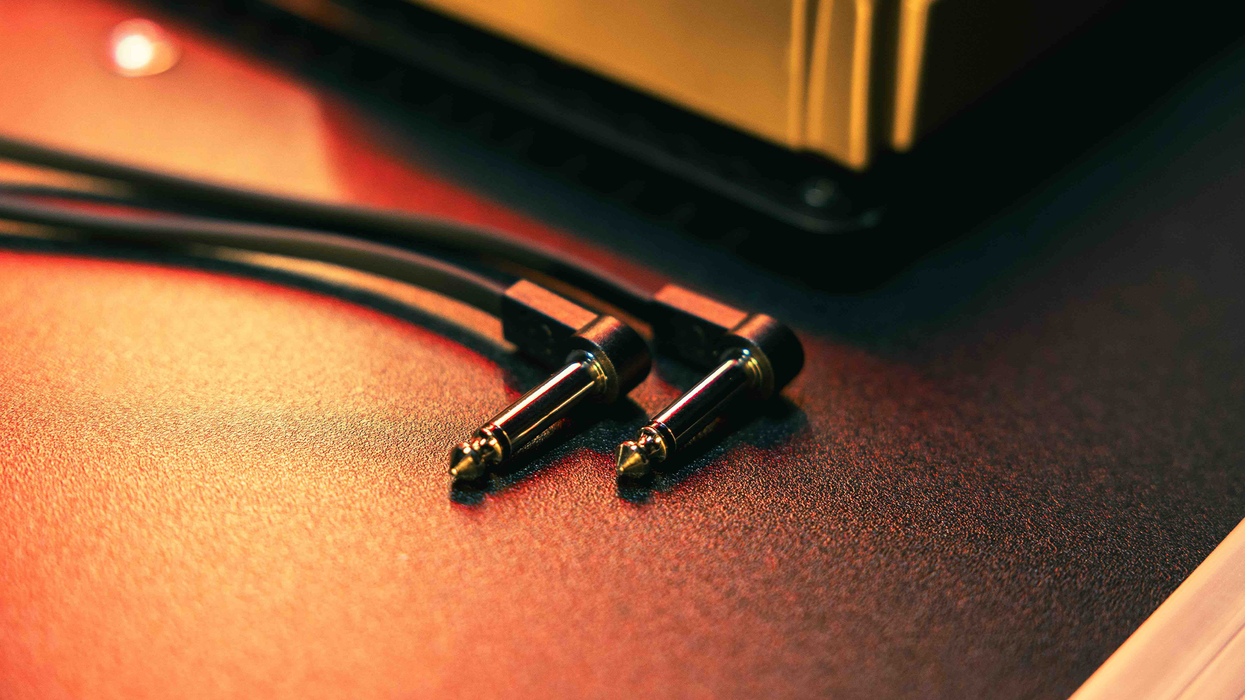
Tight spacing between pedals calls for a tighter cable approach. Gator Cableworks now offers a space-saving option with the launch of Flat Patch Cables, available as part of its Composer Series collection of high-quality audio cables.
The Composer Series Flat Patch Cables are built for musicians who demand premium signal integrity and efficient pedalboard management. Each cable features slim, compact connectors that fit into tight spaces and adapt to a variety of challenging pedal layouts, helping reduce clutter and maximize usable surface area on crowded boards.
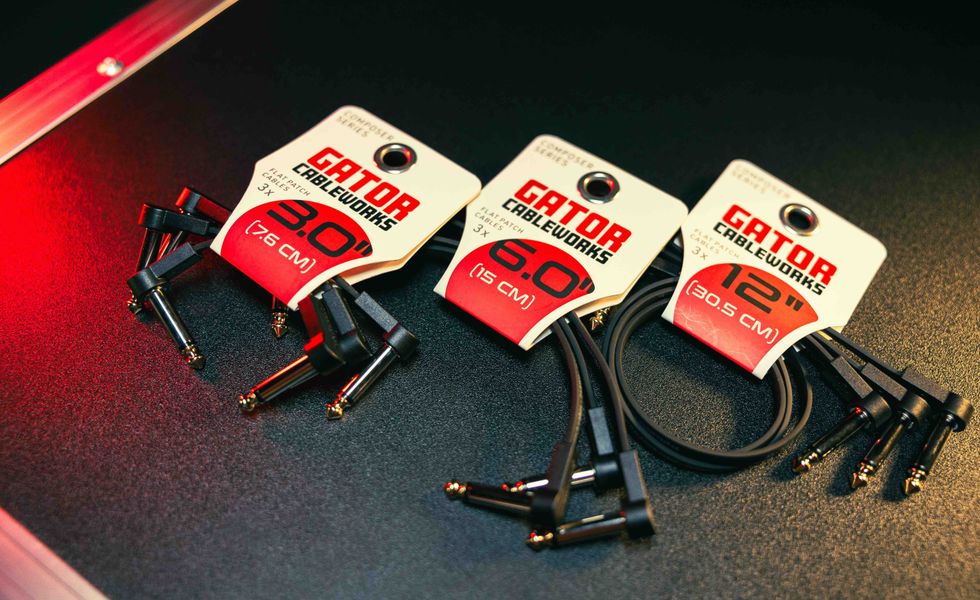
Engineered for high performance, the cables feature 99.99% oxygen-free copper conductors to ensure clear signal transmission. The 24 AWG low capacitance construction helps preserve tone while minimizing interference, and a double-shielding layer delivers a 100% shielding factor to guard against noise and RF disruption.
Each cable includes TS male right-angle ¼-inch connectors with nickel-plated housing and 24K gold-plated contact tips, providing optimal conductivity and corrosion resistance for long-term reliability.
The Composer Series Flat Patch Cables are available in the following sizes and pack options: 3-inch, 6-inch, 12-inch and 24-inch lengths, as well as 3-packs of 3-inch, 6-inch and 12-inch models. All Cableworks cables are backed by a Limited Lifetime Guarantee.
For more information, please visit www.gatorco.com.
5 Steps to Better Hybrid Picking
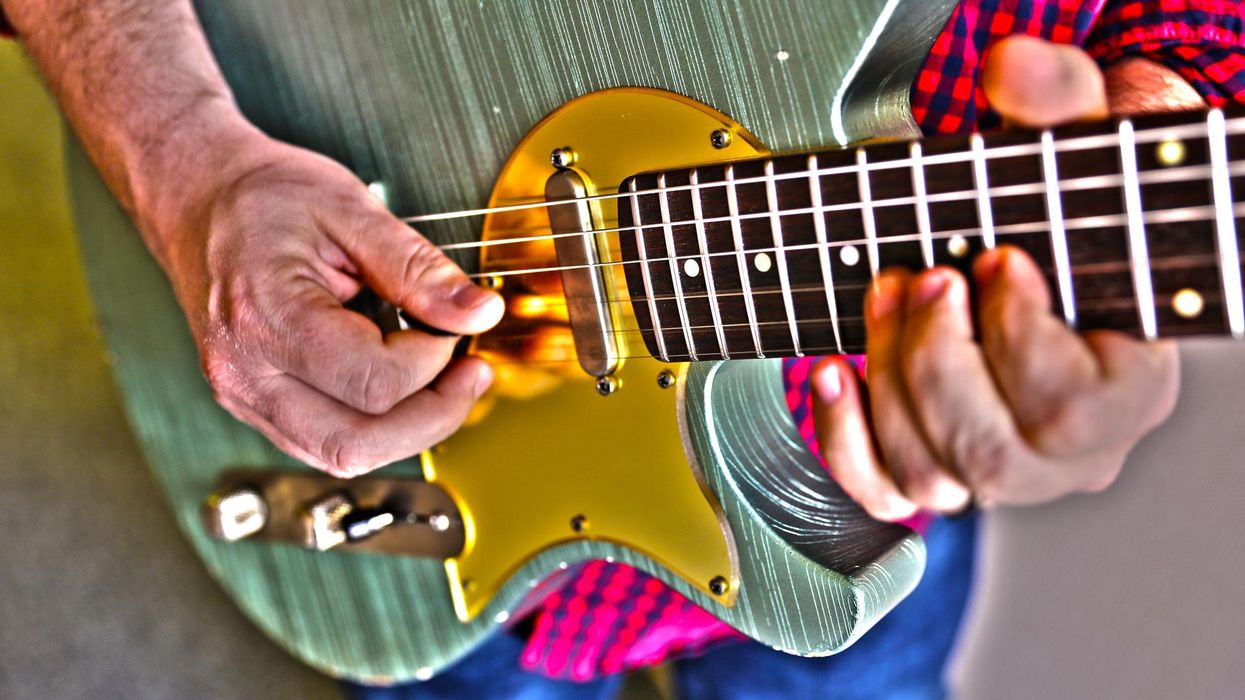
The first thing most guitarists think of when they hear the phrase “hybrid picking” is undoubtedly twangy Telecasters. While that may be the most common use of hybrid picking, it is far from the only application. Diving into hybrid picking opens a whole new world of control, timbre possibilities, ideas, speed, and more.
As beginning guitarists start to move into the intermediate level, they typically build speed by practicing alternate or economy picking. It makes complete sense–especially to someone who’s new to the journey–that if you’re holding a pick, that’s what you should strike the strings with. I grew up learning how to play taking a slightly different route. Personally, I found it easier to be faster–and cleaner–to hybrid pick phrases, lines, and solos. It clicked with me and therefore was the technique I homed in on when growing from a beginner to an intermediate player. My alternate and economy techniques still aren’t as comfortable as hybrid picking, so here are some ideas from a guy that learned things from a bit of a different perspective. If you feel like your playing has plateaued, this might help you to keep climbing.
Small note: I use the pad of my fingers when hybrid picking and not the nail.
Step 1: Focus on the Small Differences
In Ex. 1 you’ll find what I consider to be one of the main benefits of getting comfortable with hybrid picking. I pick every note of the phrase on the first pass, but hybrid pick it on the second. On the second pass, the root note (open 4th string) is the only note the pick hits. I generally like to approach hybrid picking with an “each finger is assigned a string” method, meaning in this example the middle finger picks the note on the 3rd string and the ring finger picks the note on the 2nd string. Listening to the same two phrases played differently, you’ll note that there’s a tad more feel and nuance the second time through. These are subtle but can make all the difference in the world when it comes to creating, playing, recording, or performing parts. The combination of a mountain’s worth of small differences like this are what sets the pros apart!
Step 2: How to Play Chords with Hybrid Picking
Ex. 2 is how I love to use hybrid picking when comping. In this example the pick is handling everything on the 5th string while the middle finger picks the 4th string, the ring finger picks the 3rd string, and the pinky picks the 2nd string. Not only does hybrid picking this groove allow for a ton of control, it allows the pick to rhythmically separate from the rest of the fingers, creating a faux bassline. Again, using the middle, ring, and pinky fingers give a softer touch to the upper end of the chords, creating a more nuanced feel.
Step 3: Time to Go Low
Taking the idea of the pick handling the low end of the chords and giving the notes focus while the fingers contribute to clarity and softness on the upper end of the chords, we get Ex. 3. The pick only strikes the 6th string, while the middle finger picks the 3rd string, and the ring finger picks the 2nd string. This example of hybrid picking is widely used by guys like John Mayer and allows a player to have a ridiculous amount of control over what strings are being struck when playing something clean such as this.
Step 4: Let’s Get Sweeping
Applying this concept to lead playing, Ex. 4 replaces what would typically be an upward sweep with hybrid picking. The pick strikes the A note on the 7th fret of the 4th string. Then, the middle finger picks the C# on the 6th fret of the 3rd string, the ring finger picks the E note on the 5th fret of the 2nd string, and the pick strikes the F# on the 7th fret of the 2nd string. This is followed by a downward sweep of the same notes in reverse order. To end the lick, I pick the open 4th string. That’s when hybrid picking allows me to play a rolled Dmaj7 chord. These two embellishments are highly useful when both soloing and comping, and once again are a small touch that provides some “spice.”
Step 5: Enough with the Clean Stuff
Ex. 5 is a lick I use (I should probably say abuse) consistently. My sweep picking skills are abysmal. In part because I haven’t dedicated the appropriate time to practice them, but also partly because I tend to hybrid pick as a cheat or workaround. The lick is based on a G major arpeggio beginning at the 10th fret of the 5th string. I then pick the 4th string with my middle finger and the 3rd string with my ring finger. From there, I gather for a few notes with the pick on the 3rd string and repeat the pattern again across the fretboard. However, the second hybrid-picked part of the lick begins by striking the 9th fret of the 3rd string with the pick, then using my middle finger to pick the 8th fret of the 2nd string and my ring finger to pick the 7th fret of the 1st string. To end the arpeggio, I strike the 10th fret of the 1st string with the pick. The last bit of the phrase is a garden variety blues lick ending.
Hybrid picking is an extremely valuable tool that I think every guitar player should have in their arsenal. A player can have more control, feel, and timbral options compared to only using a plectrum, and it’s an easier way to add velocity with very minimal right-hand movement or tension. Try hybrid picking different grooves, licks, arpeggiated chord shapes, and even pieces of lead lines you already know to begin exploring how the technique can work for you.
Mr. Black Creates a Powerful Analog Time-Modulator
Continuing to shatter the boundaries of what is possible within the analog time-modulation domain, Mr. Black is proud to announce the all-new Mod.One - Analog Modulator. The Mod.One combines chorus, flanger and “high-band” flanger into a single compact pedal, readily capable of creating each effect independently, and further expanded by its ability to seamlessly morph between these processes on the fly, bridging the gaps between the classic, related modulation sounds, while affording all-new tones and possibilities.
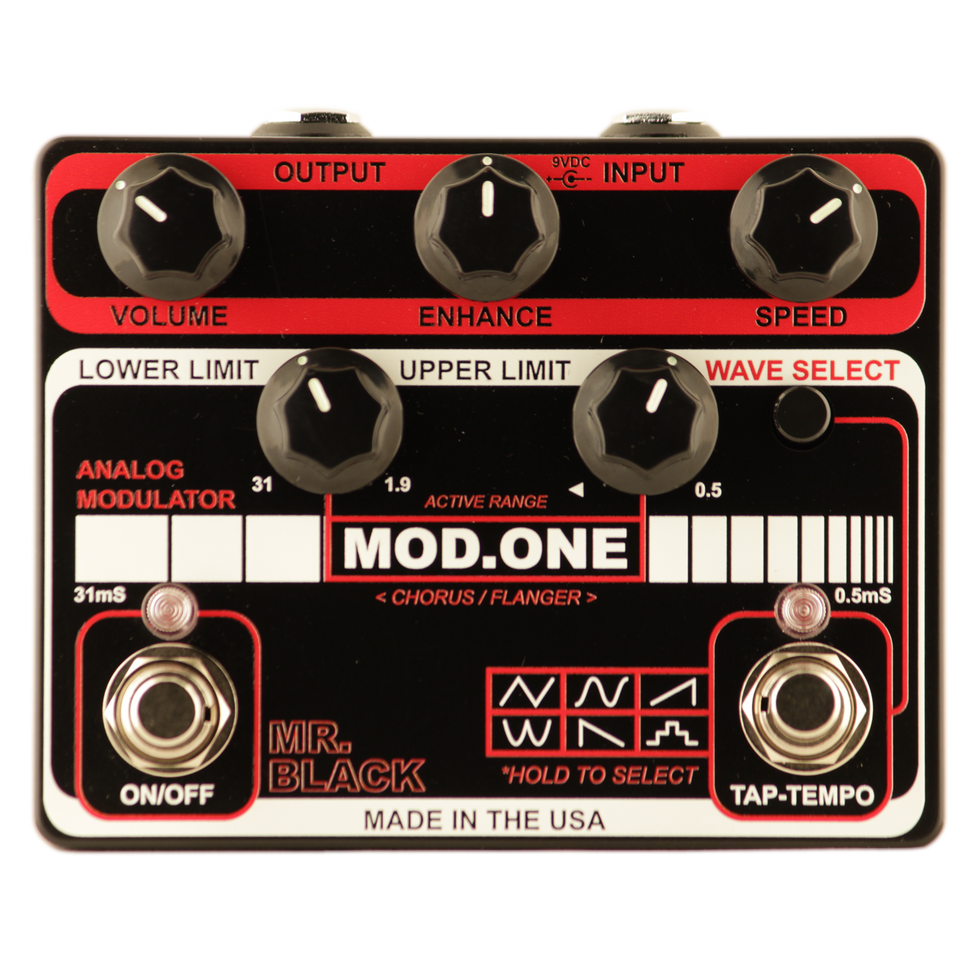
Hand built and individually calibrated, the Mod.One also includes Click-Less relay true-bypass, six waveforms and precision tap-tempo, delivering premium analog modulation in a built-to-last compact and handsome package.
Key features:
• 100% analog signal path
• Wide range of LFO speeds
• Six waveforms
• Tap-Tempo
• Click-Less True-Bypass
• Powered by “Industry Standard” 9VDC
The Mod.One carries a MAP of $249.95 and is handmade, one-at-a-time in Portland, Oregon U.S.A. Available at: www.mrblackpedals.com and retailers worldwide.
Hammer Time: How a New Tool Is Changing How Luthiers Understand Tonewood

Over the past few decades, I’ve devoted much of my lutherie career to understanding musical-grade tonewoods and the instruments that they become. While some builders seem to assess wood instinctively, I’ve always needed real, solid data—something concrete to show how a material behaves and how to best use it. That meant diving deep into the science: analyzing frequency, weight, and stiffness to understand how, and why, these characteristics shape an instrument’s sound.
One of the most powerful tools for this kind of work is the FFT (Fast Fourier Transform) analyzer, which lets you track and study anything that vibrates or makes sound. When testing tonewoods or working on guitars, FFT analysis is indispensable. Over the years, I tried a variety of FFT systems, but eventually adopted SpectraPlus by Pioneer Hill Software. It elevated my analysis to a whole new level. Even mobile FFT apps, though a bit quirky at times, have their place. I’ve had one on my phone for over 15 years. They’re a great entry point for players and curious minds alike.
In 2024, a major breakthrough occurred: the launch of the Acousonix Sonic Hammer, which I helped develop. This handheld device detects and displays the primary resonant frequencies of almost anything you tap. For tonewoods, it reveals key modal frequencies that help gauge a piece of wood’s acoustic potential. For guitars, it’s both insightful and fun: You can tap the top to measure its resonance, hold it near the soundhole to detect air resonance, or tap the back to read the back plate’s voice. Together, these readings paint a clearer picture of the instrument’s tonal fingerprint.
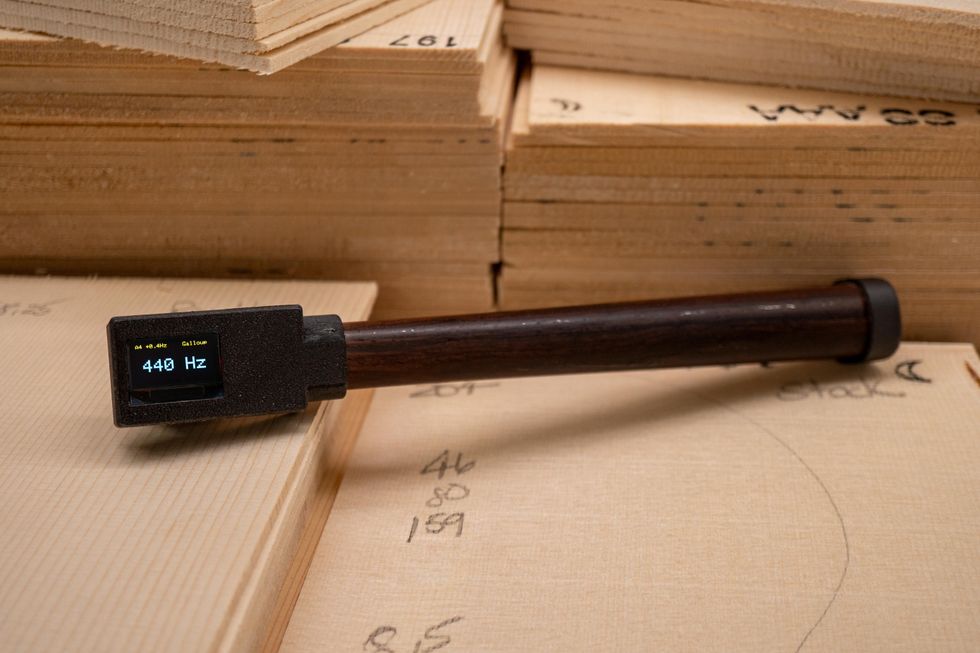
Say you’re comparing two guitars: One feels more “alive,” but you can’t explain why. By sampling each guitar you’ll likely see frequency differences tied to weight, tension, and structural behavior. That kind of information can help guide buying decisions, repair work, or just satisfy your curiosity.
Although we originally developed the Sonic Hammer for tonewood analysis, its applications have since expanded. With smart software updates and continued experimentation, we’ve used it to fine-tune banjo heads, drums, archtop guitars, and even ukuleles. Today, it’s being used in studios, repair shops, manufacturing facilities, and by tonewood sawyers to help improve yield, quality control, and efficiency.
It’s no surprise that everyday players, collectors, and music shops have embraced the hammer, not just for smarter purchases, but to better understand their instruments, inventories, and collections. Once a guitar’s sonic footprint is captured, you can track it over time. Whether it’s aging, humidity, or environmental shifts, this tool provides a simple way to monitor and preserve an instrument’s acoustic health. In recording studios or on the road, if an instrument is problematic, the hammer helps engineers and guitar techs zero in on where the problem may lie. While broader implications are still unfolding, the technology is already proving both rewarding and, yes, a little disruptive. But in time, this kind of data will likely become standard in the industry.
“This handheld device detects and displays the primary resonant frequencies of almost anything you tap.”
The Founders Edition focused on detecting primary resonances, but what’s coming next is even more exciting: deeper analysis of voicing, damping, and admittance, plus built-in Bluetooth for integration with more advanced systems. Most importantly, this tool can support something I’ve long believed in: responsible tonewood use. If we want to conserve the world’s most valuable musical materials, we need smarter ways to measure and manage them. I believe the Sonic Hammer can play a meaningful role in that effort.
For guitar makers and players, we’re living in a truly exciting era. For years, I said, “This is going to take off,” and every couple of years it felt just around the corner. But during the COVID shutdown, something changed. People had time to explore, to experiment, and the science of acoustics started to catch fire. These are exciting times indeed.
For more info, visit acousonix.com.
DiMarzio Launches Colossal™ Neck & Bridge Pickups for 5-String Bass
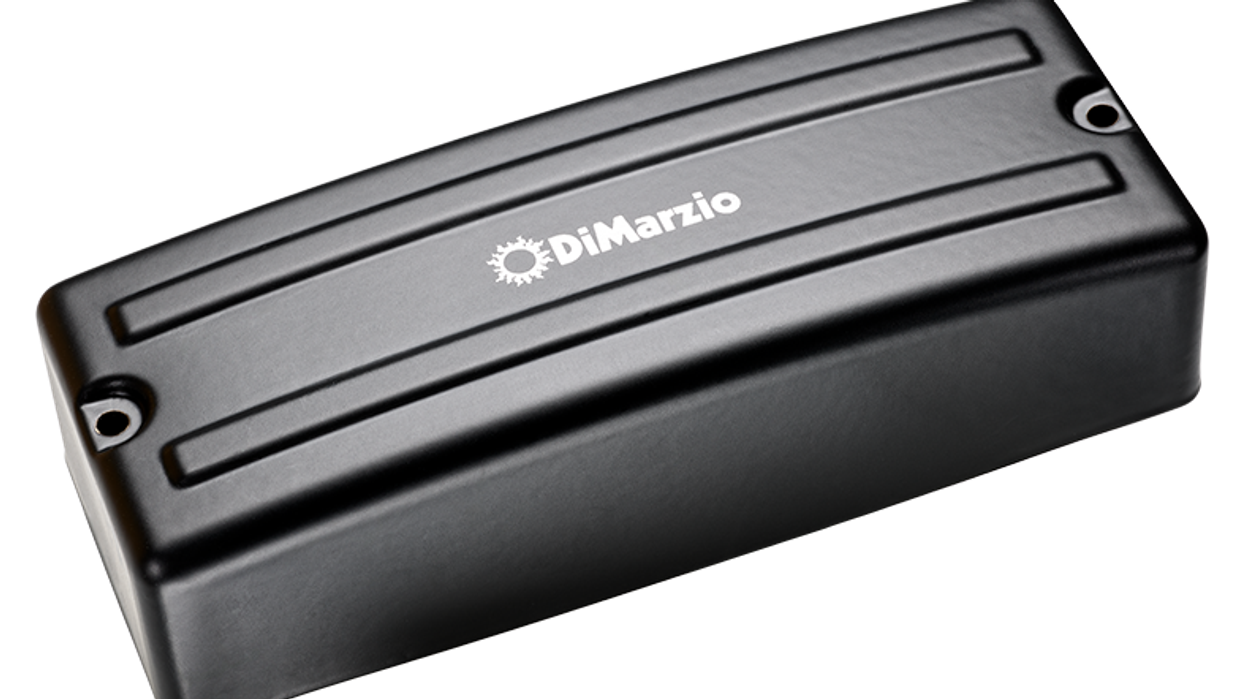
Living up to its name, “Colossal,” this pickup set has more of everything. Play them softly and they deliver an unmatched airiness to the notes; play them aggressively and they will blow your hair back. These passive pickups are designed to effortlessly respond to soft touch, slap, or aggressive pick attack with ease.
As with our game changing Relentless™ pickups, we removed all the hard edges from the metal covers, and added an arch to the top contour, bringing the sensing coils closer to the middle strings. These improvements increase the string balance and overall dynamic range.
The Colossal™ pickups are a fully humbucking design and are completely shielded, making them a better choice for both recording and live shows. These pickups can be used with the coils in series, parallel, or split configurations, making multiple sounds easily achievable without the need for digital filters. The Colossal™ Bridge and Neck can easily be combined with active electronics.
Using a thick .09375” circuit board baseplate as the foundation, the Colossal™ pickups are simple to install and use our quick connect cable system. The soapbar shaped (EMG40® sized, 37.75mm x 101.25mm) pickups incorporate Neodymium magnets, producing significantly more output and dynamic range than traditional active or passive pickups.
To improve the balance when both pickups are used together, we made the bridge position pickup louder than the neck position pickup. When the pickups are blended, you get a better volume match.
Colossal™ pickups have a richly detailed mid-range that growls, delivering notes with definition and openness, and they work well with dropped tunings. The highs are present and precise without harshness, and the lows are thunderous and tight, like the footsteps of a giant.
Available in Nickel, Gold, or Matte Black finishes.
Linkin Park Rig Rundown
Linkin Park went on hiatus for seven years after lead vocalist Chester Bennington’s death in 2017, but last September, the band announced that they were returning with new music and a new lineup—including vocalist Emily Armstrong and drummer Colin Brittain. A new album, From Zero, was released in November 2024, followed by the single “Up From the Bottom” earlier this year, and this summer, the band tore off on an international arena and stadium comeback tour. Founding lead guitarist Brad Delson is still a creative member of the band, but has elected to step back from touring. And so on the road, Alex Feder takes his place alongside founding guitarist/vocalist/keyboardist Mike Shinoda, DJ Joe Hahn, and bassist Dave Farrell.
PG’s Chris Kies headed to downtown Nashville’s Bridgestone Arena to meet up with Mike Shinoda, plus techs Mark, Ben, and Tracy, to learn how the band pulled off their much-anticipated gigs this year.
[Brought to you by D’Addario.]
Boredom Beater
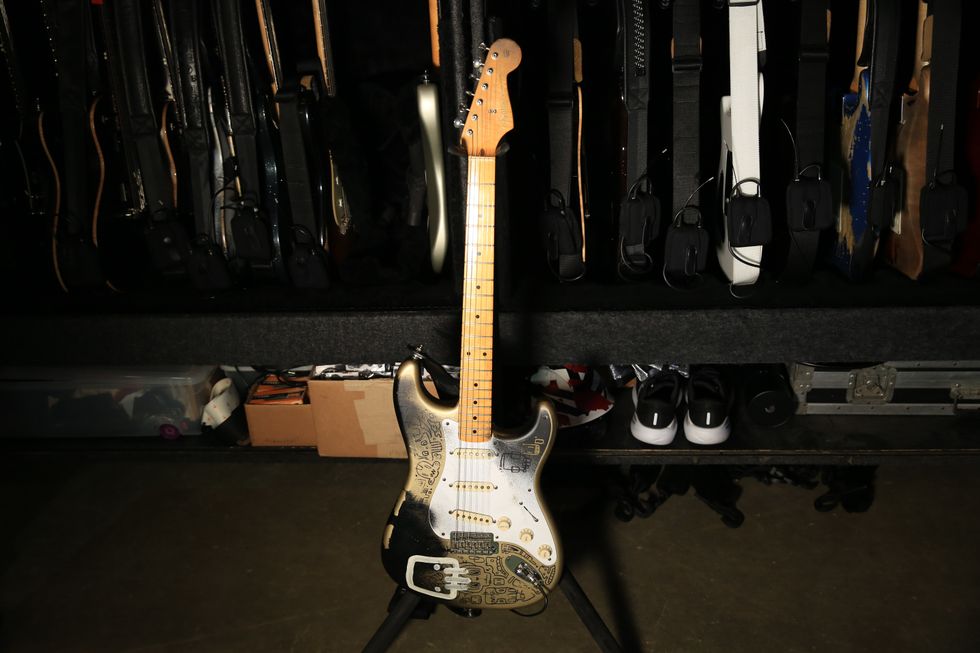
This is Shinoda’s “workhorse” Strat, a longtime trusted pal that’s featured on songs like “What I’ve Done.” There have been plenty of times when Shinoda gets bored on tour, and at one point, he started painting his guitars to keep himself occupied—including this Strat.
Painted PRS
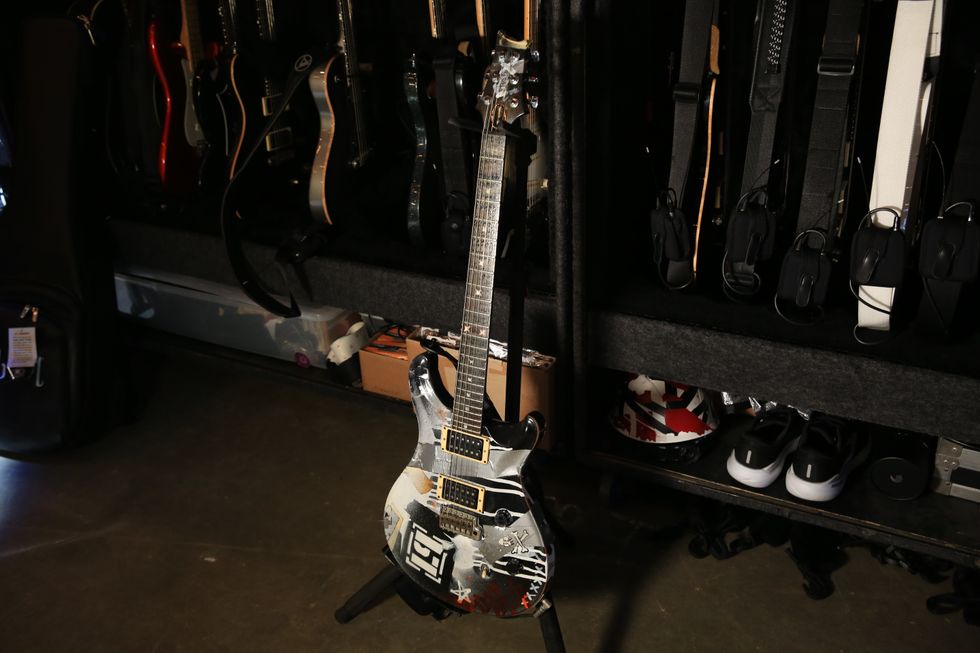
This PRS is from the band’s Meteora-era, a definitive instrument in the early years of the band. Again, the guitar’s aesthetic customizations were executed by Shinoda himself, with ink markers, spray paint, and a paint pen—plus some custom “etchings” on the fretboard. This and his other guitars are outfitted with custom Kill Spencer straps.
Blackout
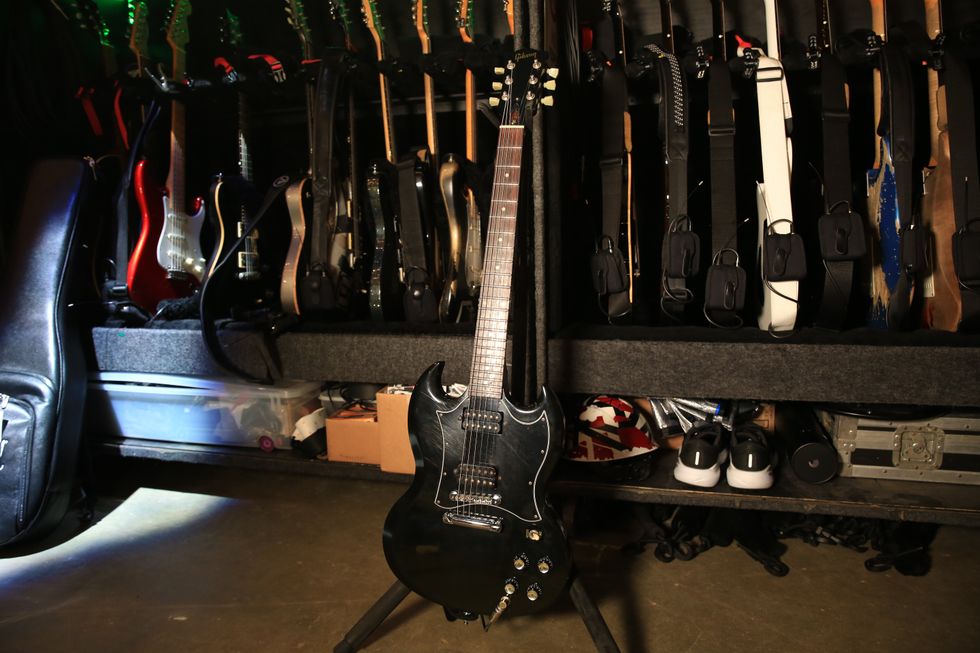
This black Gibson SG came into the picture around Linkin Park’s third record, 2007’s Minutes to Midnight.
Empty Spaces
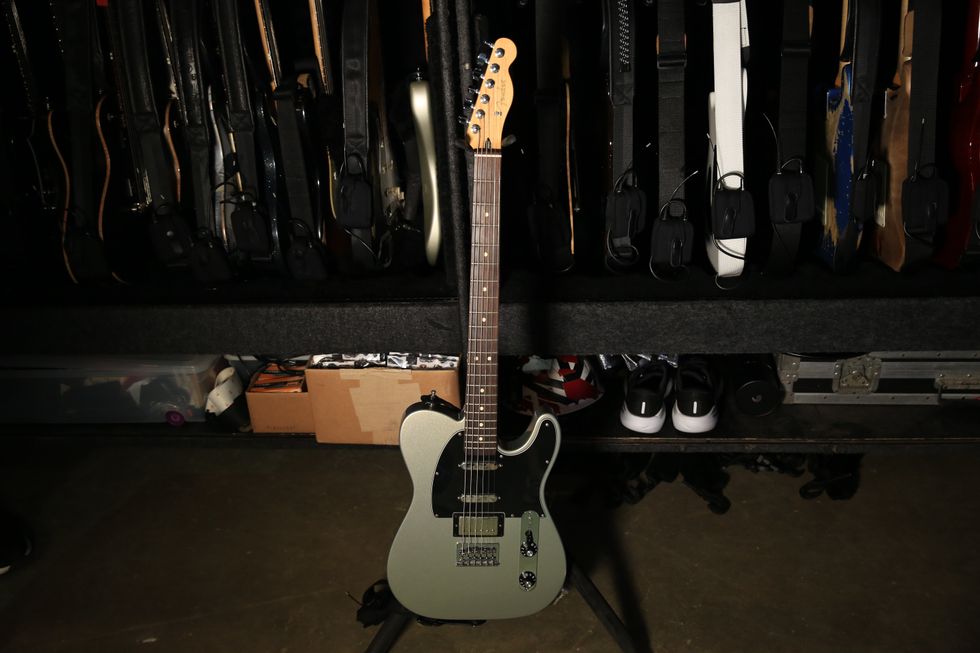
With new vocalist Armstrong’s voice filling a different spot in the band’s sound, Shinoda has adjusted some of his tunings and playing. This Fender Blacktop Baritone Telecaster helps give Armstrong’s voice space and keeps everyone in their sweet spots, frequency-wise.
Hybrid Theory Heavy
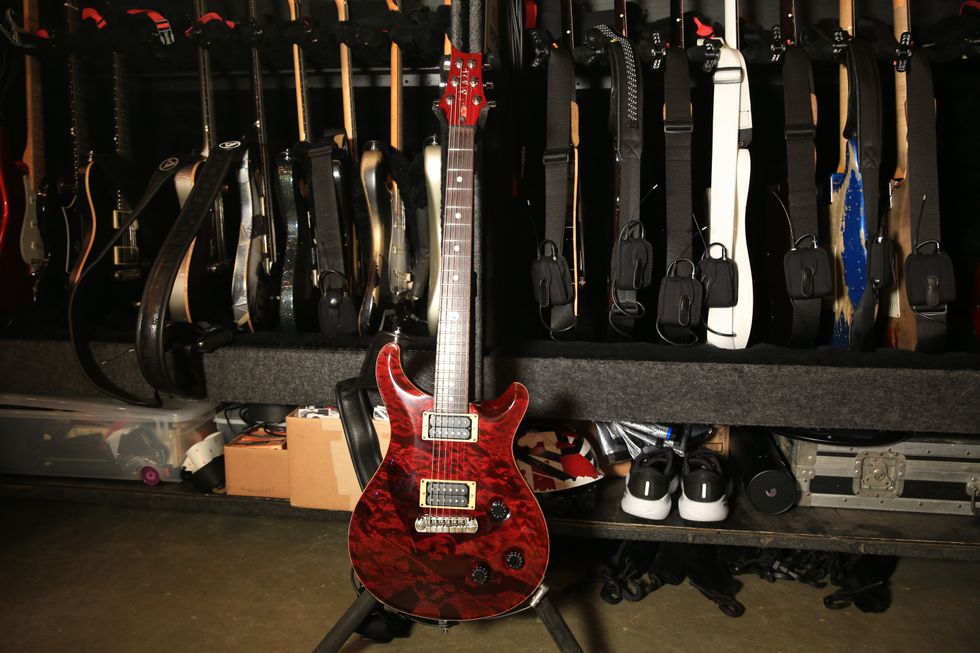
This 2008 PRS Custom 24 is a replica of Delson’s Hybrid Theory-era PRS, and sports Paul Reed Smith’s autograph on the back. It lives in drop C-sharp tuning, and if Delson is playing it, it’s loaded with D’Addario NYXLs (.010-.052). When Feder’s at the wheel, he goes for heavier top strings mixed with Delson’s packs, for a gauge range of .054-.044-.032-.017-.013-.010.
Another PRS, finished in grey and tuned to drop D sharp, features the Minutes to Midnight logo and gets brought out for “One Step Closer.” A sunburst PRS DC3 is equipped with even heavier strings for a drop A tuning: A-E-A-D-G-B.
’61 Standard
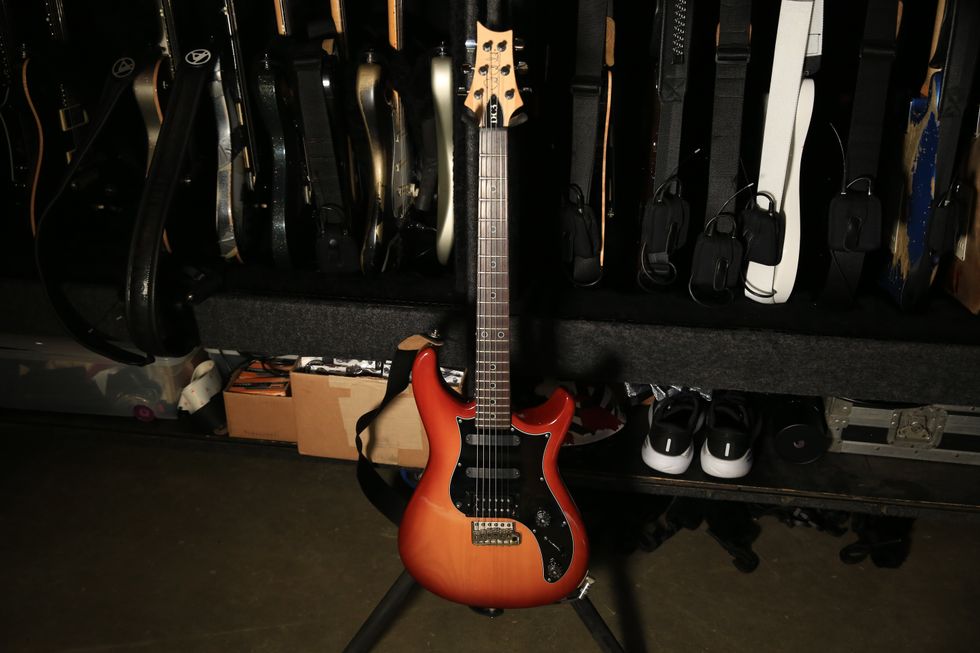
This Fender Custom Shop Rory Gallagher Stratocaster has become a staple of the live show. It’s part of a set of three that were created for Delson, designed and relic’d to mimic a 1961 Standard Stratocaster. It stays in drop D, with Delson’s standard .010-.052 strings. He uses .72mm Dunlop picks, while Feder uses slightly heavier .88mm picks.
Mike Shinoda, Brad Delson, and Alex Feder’s Rack Systems
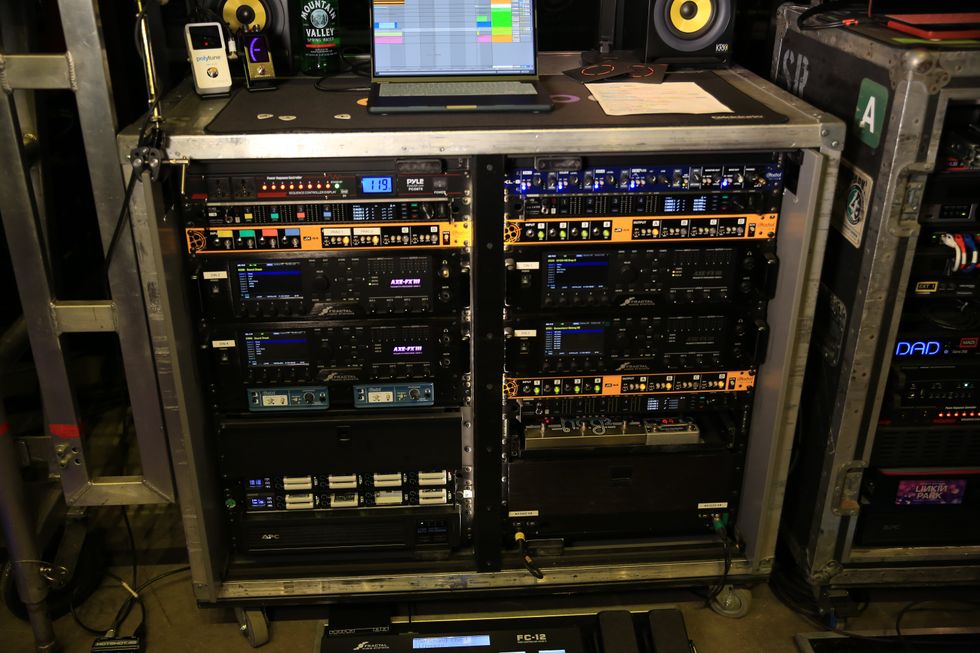
Delson’s rig (used by touring member Alex Feder) lives on the left side of this rack, while Shinoda’s takes up the right. They both include a Radial KL-8, two Radial JX44s, two Shure AD4Qs, and two Fractal Axe-Fx III units. Shinoda’s setup also includes two Electro-Harmonix HOG2 pedals. The fractals use IRs that were captured by old FOH engineer Pooch, using a Randall cabinet.
MIDI handles all of the changes for the show, though there’s a Fractal FC-12 foot controller on hand in case of emergency for manual switching. Fred Carlton of Nerdmatics, who built the Linkin Park rig for this 2024-2025 run promoting From Zero, shared some more information with us after filming: “The backline gear consists of about 11 computers running Ableton, all receiving locator information from the main playback computers. We maintain redundant computer systems for Joe Hahn’s DJ rig, Mike Shinoda’s keyboard rig, the Audio FX rig, and the Playback system. Single-computer setups are used for both guitar rigs and the bass rig, as these stations only send MIDI patch changes and do not handle audio. Additional single-computer systems are in place at Monitor World, FOH, and within the Visual department.
Each station carries an updated timeline of the show, allowing techs to insert automation data such as MIDI or timecode to control their systems. Once changes are made to the main Ableton session, we distribute updated .ALS files to all departments, enabling them to integrate their specific data into the new timeline. This workflow allows us to implement changes quickly while keeping all departments aligned. Having separate computers also gives each tech the ability to test their own system independently. In the event of losing RTP network connectivity, they can punt the show locally without relying on external automation.”
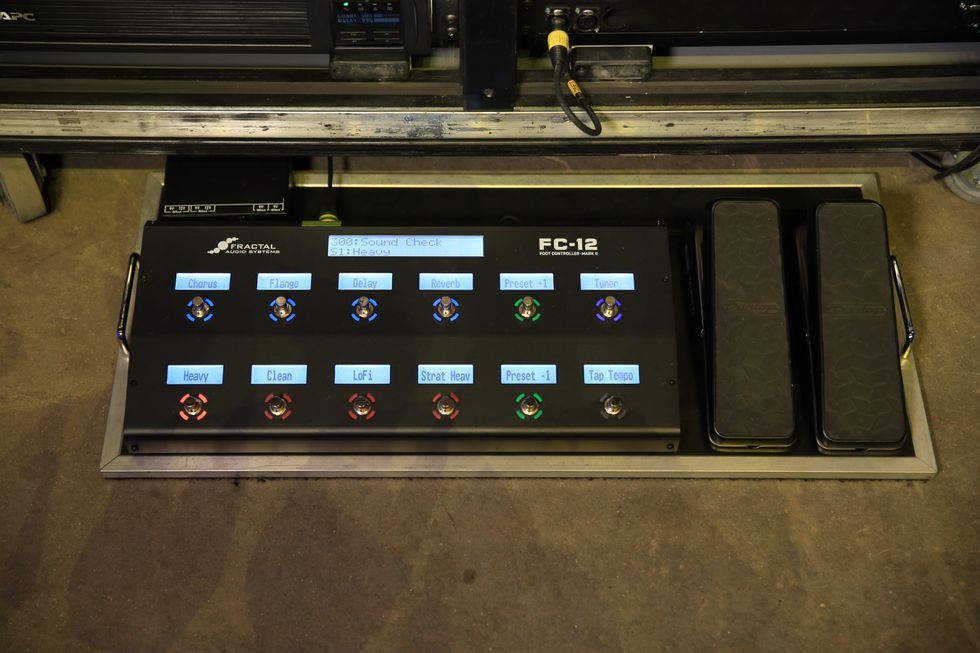
Sharpened with Precision
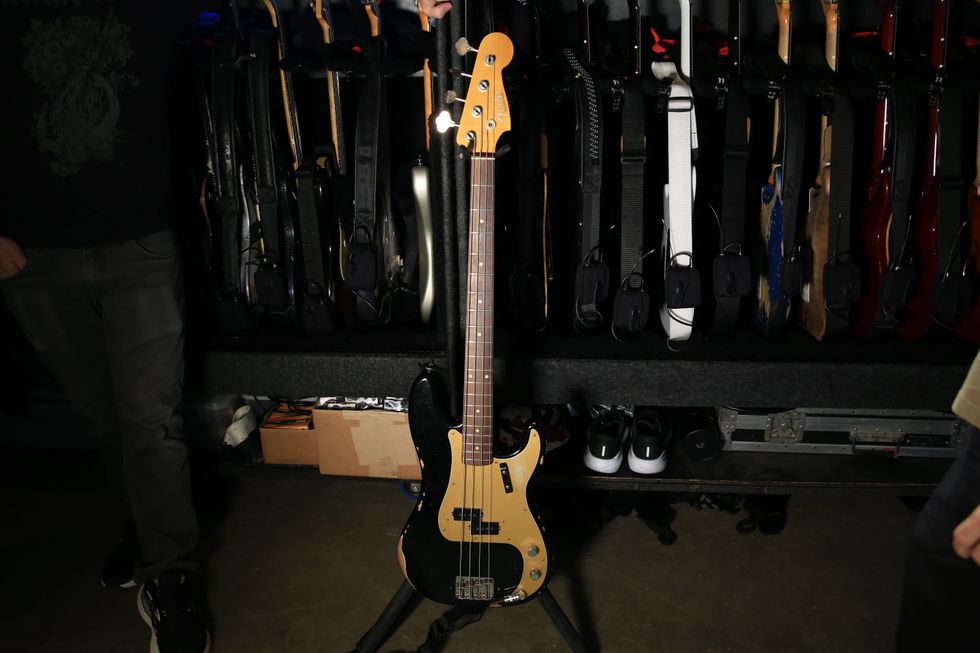
This Fender Custom Shop Precision bass is Dave Farrell’s go-to, his tech Tracy explains. It’s tuned to either drop D or standard, and Farrell uses Ernie Ball Bass Hybrid Slinky strings (.045-.105) with Dunlop .88mm picks.
Ernie Ball Basher
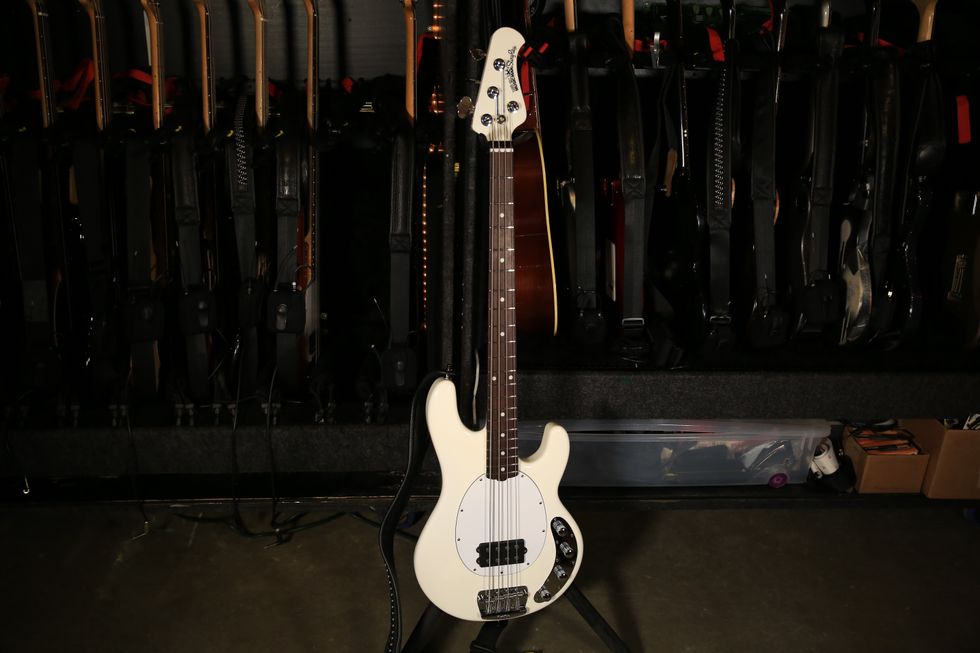
This beloved Ernie Ball Music Man StringRay, with active electronics and neck-through construction, is the second-most used bass in the rack, and comes out for hits like “Papercut” and “In the End.” It’s tuned to drop C-sharp.
Mum Knows Best
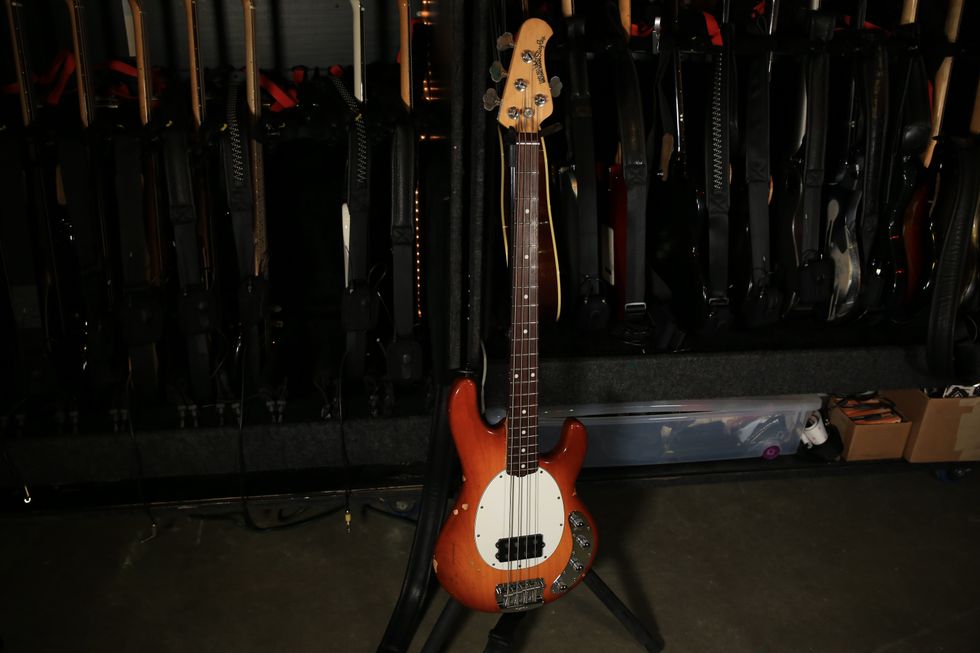
Though his other StingRay gets more play, this is the original item, which Farrell’s mother bought for him. It gets tapped for tracks “Somewhere I Belong” and “Faint.”
Dave Farrell’s Rack
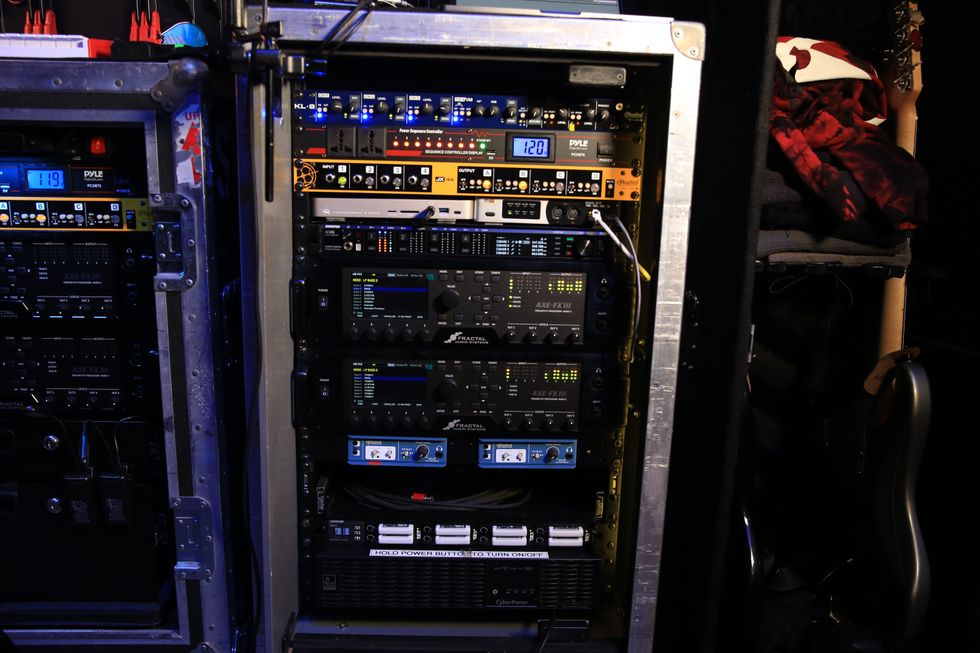
Along with the same accoutrements (Radial KL 8 and JX 44, Shure AD4Q), Farrell also uses a pair of Fractal Axe-Fx IIIs, and runs three signals—one of an Ampeg SVT model, a Marshall JMP-1 model, and a clean direct signal, run through emulations of two Ampeg 4x10 speaker cabinets—to front of house, which can mix and match between the three as needed.

Fender Custom Shop Rory Gallagher Stratocaster
Fender Custom Shop Precision bass
Ernie Ball Bass Hybrid Slinky Strings (.045-.105)
Band Industries Launches Roadie 4 Automatic Guitar Tuner
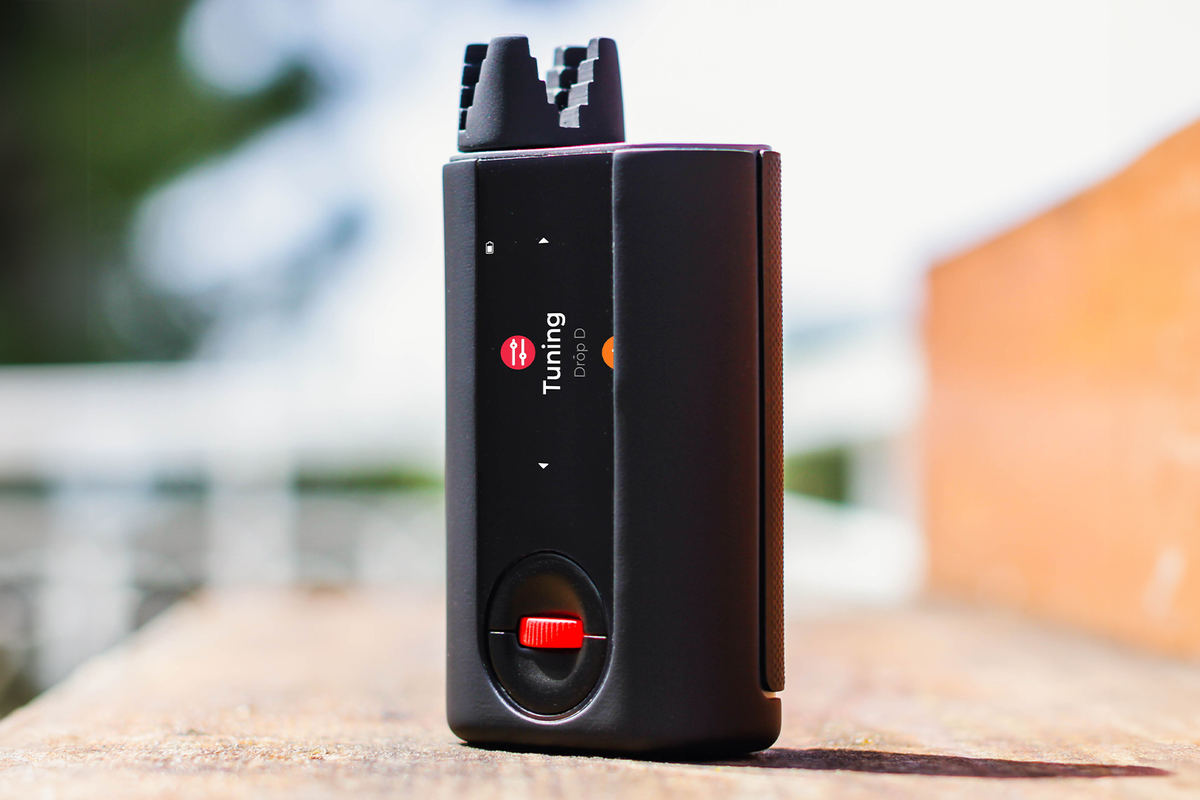
Band Industries has unveiled Roadie 4, the latest generation of the company’s innovative automatic tuners.
Designed for fast, reliable tuning for nearly any instrument with geared pegs, the new tuner is built from the ground up with enhanced accuracy and usability. Roadie 4 delivers a smoother, faster, and more reliable tuning experience. With revamped algorithms and upgraded audio circuitry, it offers excellent noise immunity and pinpoint tuning accuracy, whether you're tuning on stage, in a noisy rehearsal room, or at home.
Key new features include:
- Completely reengineered algorithms and audio circuitry for superior tuning accuracy and better performance in noisy environments
- Larger 1.9" full color LCD screen with over twice the display area for greater visibility when tuning
- New intuitive scroll wheel for lightning fast selection and navigation
- Auto detect feature: In previous models, Roadie tuned your instrument in a fixed sequence lowest to highest string or required manual string selection. Now, just pluck any string. Roadie 4 will automatically detect which string you are on, tune it precisely, and notify you when it is in tune with a vibration and audible beep
- Redesigned peg connector to accommodate a wider range of larger and smaller pegs
- Improved ergonomics: Taller build, anti slip backing, and a more natural, secure grip
Band Industries introduced the original Roadie Tuner in 2014, followed by the breakout Roadie 2 in 2017 and the powerful Roadie 3 in 2020. Roadie 4 builds on that legacy and provides even better performance.
From electric and acoustic guitars to mandolins, ukuleles, banjos, and more, Roadie 4 tunes almost any instrument with geared pegs. It also winds new strings quickly and accurately, making string changes a breeze.
Roadie 4 is available for street price of $139. For more information visit roadiemusic.com.

